–
太極拳使用法
METHODS OF APPLYING TAIJI BOXING
董虎嶺
by Dong Huling
[1956]
[translation by Paul Brennan, Jan, 2017]
–
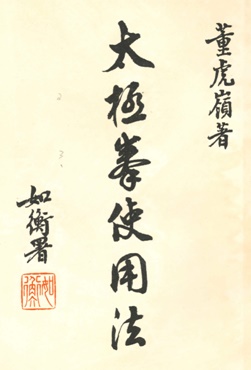
董虎嶺著
by Dong Huling:
太極拳使用法
Methods of Applying Taiji Boxing
如衡署
– calligraphy by [Li] Ruheng
–

董英傑老師像
Portrait of Dong Yingjie
–
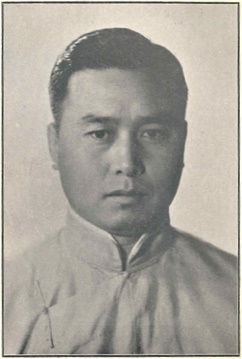
董虎嶺像
Portrait of Dong Huling
–
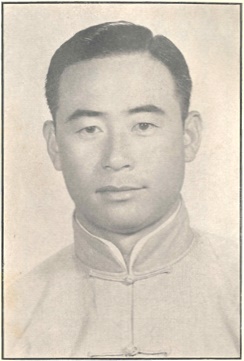
董峻嶺像
Portrait of Dong Junling
–
太極拳使用法目錄
CONTENTS
序文
Prefaces
凡例
General Comments
打手歌
Playing Hands Song
打手歌詳解
Detailed Explanations for the Playing Hands Song
十三勢使用法
Methods of Applying the Postures in the Thirteen Dynamics Solo Set
一 攬雀尾
1. CATCH THE SPARROW BY THE TAIL
掤式
WARD-OFF POSTURE
捋式
ROLLBACK POSTURE
擠式
PRESS POSTURE
按式
PUSH POSTURE
二 單鞭
2. SINGLE WHIP
三 提手
3. RAISE THE HANDS
四 白鶴亮翅
4. WHITE CRANE SHOWS ITS WINGS
五 左摟膝拗步
5. LEFT BRUSH KNEE IN A CROSSED STANCE
六 手揮琵琶
6. PLAY THE LUTE
七 進步搬攬錘
7. ADVANCE, PARRY, CATCH, PUNCH
八 如封似閉
8. SEALING SHUT
九 十字手
9. CROSSED HANDS
十 抱虎歸山
10. CAPTURE THE TIGER AND SEND IT BACK TO ITS MOUNTAIN
十一 肘底看錘
11. GUARDING PUNCH UNDER ELBOW
十二 倒輦猴
12. RETREAT, DRIVING AWAY THE MONKEY
十三 斜飛式
13. DIAGONAL FLYING POSTURE
十四 海底針
14. NEEDLE UNDER THE SEA
十五 山通背
15. MOUNTAIN THROUGH THE BACK
十六 撇身錘
16. TORSO-FLUNG PUNCH
十七 雲手
17. CLOUDING HANDS
十八 高探馬
18. RISING UP AND REACHING OUT TO THE HORSE
十九 右分脚
19. KICK TO THE RIGHT
二十 左轉身蹬脚
20. TURN TO THE LEFT, PRESSING KICK
廿一 進步栽錘
21. ADVANCE, PLANTING PUNCH
廿二 斜身右蹬脚
22. INCLINING BODY, RIGHT PRESSING KICK
廿三 左打虎式
23. LEFT FIGHTING TIGER POSTURE
廿四 回身右蹬脚
24. TURN BACK, RIGHT PRESSING KICK
廿五 雙風貫耳
25. DOUBLE WINDS THROUGH THE EARS
廿六 野馬分鬃
26. WILD HORSE VEERS ITS MANE
廿七 左玉女穿梭
27. MAIDEN WORKS THE SHUTTLE
廿八 單鞭下式
28. SINGLE WHIP, LOW POSTURE
廿九 金雞獨立
29. GOLDEN ROOSTER STANDS ON ONE LEG
三十 白蛇吐信
30. WHITE SNAKE FLICKS ITS TONGUE
卅一 高探馬代穿掌
31. REACHING OUT TO THE HORSE, SWITCHING TO THREADING PALM
卅二 轉身十字腿
32. TURN AROUND, CROSS-SHAPED KICK
卅三 進步指襠錘
33. ADVANCE, PUNCH TO THE CROTCH
卅四 上步七星錘
34. STEP FORWARD, BIG DIPPER PUNCH
卅五 退步跨虎
35. RETREAT, SITTING TIGER POSTURE
卅六 轉身雙擺蓮
36. TURN AROUND, DOUBLE-SLAP SWINGING LOTUS KICK
卅七 彎弓射虎
37. BEND THE BOW, SHOOT THE TIGER
四正四隅使用法
Methods of Applying of the Four Primary Techniques & Four Secondary Techniques
掤
WARDING OFF
捋
ROLLING BACK
擠
PRESSING
按
PUSHING
採(其一)
PLUCKING (version 1)
(其二)
(version 2)
挒(其一)
RENDING (version 1)
(其二)
(version 2)
肘(其一)
ELBOWING (version 1)
(其二)
(version 2)
靠(其一)
BUMPING (version 1)
(其二)
(version 2)
–
潘序
PREFACE BY PAN SHOUREN
練太極拳者,由初學入門起。經相當時日。得其形式。如獲良師指導。益友切磋。姿勢正確無訛。開步運拳。乃漸有意義。此時作為健身運動。綽有餘裕。而志在深造。欲得技擊工夫者。當精益求精。鍛鍊不懈。但太極拳精微深奧。若祇一知半解。勉強從事。未得中肯。往往誤入歧途。例如以意行氣。每變成鼓氣怒視。窒礙不通。弄巧反拙。剛柔相濟。則誤軟為柔。以硬作剛。馬步非失之板滯雙重。則失於飄浮不穩。開展旣茫無法度。緊湊又手足不舒。此種練法。勞而無功。致力多年。終難進步。漸怨太極拳徒有玄妙之稱。毫不切於實用。因而灰心引退。殊非鮮見。予從虎嶺先生習拳以來。上述弊病。漸知避免。但仍時乞指正。未敢稍懈,年前英傑老師蒞泰。晨昏教誨。勉以欲得真正太極功夫。須明用法。蓋太極拳動作。有不易之理。開步運拳。分寸皆含用意。譬諸運掌向前。如未明用意。則不知應伸展多少。勁注何處。苟明其理。便能依適當位置。上下相隨運勁使出。姿勢正確。自感勁力不同。而興趣亦愈趨濃厚。日常練拳時。如滲入用法之意。久之習慣成自然。身手皆有準則。便能愈練愈精。進步於無形中。茲者虎嶺先生乘回港之便。與賢昆仲峻嶺先生。現身示範。將太極拳各式用法。攝製成圖。加以解釋。掤捋擠按採挒肘靠八法。亦一幷列入。尤為錦上添花。上述圖文。彙集成冊。行將付梓。定名為太極拳使用法。予感太極拳之祕奧。于茲公開無遺。後學得之。奉為楷模。不復有誤入歧途之虞。其造福同門。光大我道。功勛豈淺鮮哉?是為序。
丙申冬潘守仁書於曼谷
Practitioners of Taiji Boxing begin with fundamentals, and then when the time is right, can learn the postures. If you obtain a good teacher to guide you, or learn through discussion with knowledgeable friends, your postures can be adjusted until they are free of error, and then you can move on to practicing the solo set, from which you will gradually gain the meaning of the art. At this point, you now have an exercise for health that is already more than adequate, but those with an ambition toward more advanced studies, who wish to obtain martial skill, should work to improve further, training perseveringly.
Taiji Boxing’s subtleties are profound. If you force your way along with an incomplete understanding, you will constantly be led astray from the right path. For example, the concept of “use intention to move energy” always ends up distorted into “rouse the anger and give glaring looks”, hindering movement and turning skill into clumsiness. Hardness and softness become muddled, limpness mistakenly being seen as softness and stiffness mistakenly being seen as hardness. Your stance then gets stuck in being double weighted, and thus you will float unstably. When you extend your posture, you are all over the place, and when you contract, your limbs become tense.
Practicing in this way, all your work will get you nowhere, and even if you devote yourself to it for many years, you will in the end hardly have progressed at all. Gradually you will blame the art itself, saying that it is too obscure and not at all practical, and as a result you will get so discouraged that you will quit. This situation is by no means uncommon. Since I learned this art from Dong Huling, I have gradually come to understand how to avoid such errors, but I still often ask for corrections and do not dare to slacken in my practice.
Last year, Dong Yingjie came to Thailand to give us the kind of instruction that fills an entire day. He pressed the point that if we wish to obtain genuine Taiji skill, we must understand application. The movements of Taiji Boxing have an unchanging principle: in every inch of movement there is use of intention. For instance, when you send a palm forward, if you do not understand how to use intention, then you will not know how far you should extend, or where power is to be focused. But if you understand this principle, then you will be able to be properly positioned, upper body and lower coordinated with each other as power is sent out. When the posture is correct, you notice how different the power feels, and your enjoyment is more and more enriched. If you focus deeply on application during your daily practice, than after a long time it will become second nature, body and hands always in the right place. Then the more you practice, the more refined your skill will become, and you will progress without even noticing.
Dong Huling has now returned to Hong Kong to personally demonstrate with his brother Junling the applications of each of the Taiji Boxing postures in photographs with added explanations. The eight techniques of warding off, rolling back, pressing, pushing, plucking, rending, elbowing, and bumping are also demonstrated, making something already great even better. This book of photos with accompanying text is now ready to go the printers. He has called it Methods of Applying Taiji Boxing. I feel that the art’s subtleties will now be fully available to the public and that new generations of students will have a proper model to work from so that they no longer have to worry about being led astray. It will be of no small service to colleagues promoting our traditions. Thus I write this preface.
– written by Pan Shouren in Bangkok, 1956
–
林序
PREFACE BY LIN BOYAN
夫太極一拳。取法於易之太極陰陽消長。八卦相盪之理。參以技擊之精華。演繹而成。包含生理動力心理哲學等原理。學者可以卻病延年。可以防身自衞。動作輕鬆和緩。循乎自然之意志。促使精氣周流四體百骸。則心腎相交。水火旣濟。姓命葆真矣。物極則反。激則變。故柔極為剛。剛而不怒。剛極必柔。柔而不衰。從順處逆。陰陽相濟。精微自至。從心所欲矣。行拳然。推手亦然。使用法亦莫不然。董老師英傑哲嗣虎嶺師兄。幼承家學。廿載純功。早已爐火純青。造詣之深。非同門儕輩之所及也。曩歲授藝河北時。東鄰柔道之士。屢請試手。虎嶺兄婉謝未果。許之。屢試屢捷。時逼於環境。未盡所長。然對方固已懾伏。欽仰不勝矣。一九五二年春。承暹方僑領多人禮聘。赴暹闡揚太極拳術。循循善誘。桃李盈門。吾道其南。蜚聲異域。近以其多年心得與經驗。編著太極拳使用法一書。由虎嶺峻嶺賢昆仲逐式攝圖說明。另附掤捋擠按採挒肘靠八法圖解。將付剞劂。太極宗法。又多一佳作也。屆時人手一篇。先睹為快。紙貴洛陽。當可預卜矣。遠道聞之。謹識俚語為祝。非敢言序也。
八閩林伯炎書於馬來亞雪蘭莪中國精武體育會
The Taiji boxing art is based upon the “grand polarity” [tai ji] concept in the Book of Changes, involving the waxing and waning of the passive and active aspects, and the principle of the eight trigrams affecting each other. Examine the essentials of these boxing skills and this becomes clear. The art embodies principles of physiology, physics, psychology, and philosophy. Students can prevent illness, prolong life, and protect themselves. The movements are delicate and gentle, in accordance with an intention of naturalness, boosting the circulation of vital energy to the four limbs and every part of the body. The heart and kidneys will thus be interrelating, water and fire benefitting each other, and life essence will be preserved.
When things reach an extreme state, they then revert toward the opposite state. Extremity causes change. Therefore softness at its peak becomes hardness, a hardness without anger, and hardness at its peak becomes softness, a softness without weakness. Coarseness [on the opponent’s part] will be produced by smoothness [on my part], passive and active complementing each other. Subtleties will become so refined that you are able to do as you please. This is the case whether practicing the solo set, pushing hands, or applications.
Dong Yingjie’s eldest son Huling learned from his father since his youth and became highly skilled by the age of twenty. Due to reaching such a degree of expertise so early, his attainments are profound, unmatched by other practitioners of his generation. During the years Huling was teaching the art in Hebei, Judo masters from Japan frequently challenged him. He would politely decline but then accept once the challenge was repeated. He won every time. Even in a difficult position, he would never use his full ability. Opponents conceded defeat sincerely and then gave him their undying admiration.
In the spring of 1952, he was ceremoniously invited by many leaders of the Chinese community in Thailand to come spread the Taiji boxing art there. Giving methodical instruction to many students, he has become famous in these foreign lands despite our different ways. He has now made use of his many years of learning and experience to write his Methods of Applying Taiji Boxing. In it, he and his brother Junling present each of the postures with photographs and explanations, including depictions of the eight techniques of warding off, rolling back, pressing, pushing, plucking, rending, elbowing, and bumping.
It is about to be sent to the printers and will be regarded as an excellent work by the many schools of Taiji. On the occasion of this work appearing, I am delighted to be among the first to get to read it and can predict with certainty that it will be popular. Hearing the news of this event from so far away, I sincerely offer these inadequate words of good wishes which I would not presume to qualify as a preface.
– written by Lin Boyan of Bamin [another name for Fujian] at the Chinese Jingwu Athletic Association in Selangor, Malaysia
–
陳序
PREFACE BY CHEN SIYOU
余以商務所關。俗累紛忙。以致操勞過度。傷腦失眠。服藥旣多。積為濕毒。雖經中西名醫治療。而時愈時發。痛苦之情。莫可名狀。後幸得同門先進。由香港敦聘太極拳名師董虎嶺先生。蒞泰教授。余渴望已久。聞訊卽登門受業。蒙先生授以太極功十三勢健身法。數月而痼疾不藥而愈。予行年五十有三。練拳至今。三歷寒暑。健步若飛。超於儕輩。同門有患高血壓者。糖尿症者。消化不良者。肺癆者。麻痺不仁者。學太極拳後。槪不藥而愈。太極拳之有益於身體。蓋如是其大也。先生為太極拳尊宿英傑老師之哲嗣。家學淵源。造詣湛深。每演十三勢示範。動靜虛實。陰陽開合。靡不神氣活現。逈異凡庸。及試用法。則剛柔相濟。變化萬千。略一發勁。對方卽跌出數丈以外。常有受擊跌出。仍不知其所以然者。誠神妙不可思議。先生雖身懷絕技。但態度謙和。品格清高。尤令人敬佩。今其所著太極拳使用法一書行將刊印。囑余為之序。余本不文。然身受其益。固應樂為天下道也。
陳斯猷謹述
When I worked in business, I was very busy with worldly affairs. Consequently I became overworked, inflicted with headaches and insomnia, and was constantly popping pills, filling myself with poison. Although I tried both Chinese and Western treatments, I just kept getting worse, until the pain was beyond description. Later, some colleagues had fortunately taken the initiative to invite the famous Taiji Boxing teacher Dong Huling to come from Hong Kong and teach in Thailand. I had long yearned to learn the art, so when I heard of his arrival I went to his door to ask for instruction.
He taught me Taiji’s thirteen dynamics solo set as a method of fitness. Then after just a few months with it I had recovered from my illness without any medicine. I am now fifty-three years old, and practice this boxing art to this day, all year long. When I walk, I seem to fly, zooming past everyone else my age. Fellow students have had anxiety about high blood pressure, diabetes, dyspepsia, tuberculosis, and palsy, but after learning Taiji Boxing, they all likewise recovered without medicine, so great is Taiji Boxing’s benefit to the body.
My teacher is the son of the Taiji Boxing master Dong Yingjie, receiving from him the deepest learning and thereby attaining profound skill. Whenever he demonstrates the solo set, there is movement and stillness, emptiness and fullness, passive and active, opening and closing, all performed with uncommon expressiveness. And when someone tries out his skill at applications, hardness and softness complement each other in endless transformations. With the slightest issuing of power, the opponent stumbles dozens of feet away, and every time he is sent away, he has no idea how it happened, for truly it is skill beyond comprehension.
Although my teacher has a consummate skill within his body, he also has an amiable manner and an aloofness from worldly things that has caused people to hold him in particular esteem. Now his Methods of Applying Taiji Boxing is ready to be published and he has urged me to write a preface for it. I am not highly literate, but my body has received such benefit from this method that it is sure to bring delight to the world.
– sincerely written by Chen Siyou
–
林序
PREFACE BY LIN SHENGTAO
太極拳者。顧名思義。為拳術也。拳脚幷用。尤着重發勁擊人遠出。剛柔相濟。手法特異。故自三峯祖師首創斯技。千載以來。獨樹一幟。不與旁技相混。昔之能者多挾技自珍。不妄傳授。故流傳不廣。今世殊事異。太極拳普遍盛行。惟習者多以體育之道目之。鮮解用法。不知用法猶諸用意。明此乃能以意運氣。遍及全身。收內固精神。強健體魄之功。若徒知手舞足蹈。漫無分寸。柔而無能。焉可得太極拳之效耶。今虎嶺先生所著太極拳使用法一書。揭示太極真相。將可使人一新耳目。後學獲此依法練習。則功夫日進。可預卜也。年前英傑老師蒞泰示範。余於奉聆教誨之餘。嘗以編印太極拳使用法為請。老師允期于返港後。今果命虎嶺先生代其勞。工竣付印。余宿願能償。聞訊雀躍。謹綴蕪句以誌慶。
太極紹真傳 武功自少專
暹疆揚妙法 拳譽滿湄川
林聖韜于暹京
Taiji Boxing, as the name suggests, is a boxing art. Though using both punching and kicking, it especially emphasizes issuing power when attacking the opponent to send him far away. With hardness and softness complementing each other, its techniques are particularly unique. Since these skills were pioneered by Zhang Sanfeng a thousand years ago, it has followed its own course, not mixing in elements from other systems. Experts in former times often kept the art to themselves like a personal treasure, not lightly sharing it with others, and thus it was not widely spread. But the situation nowadays is completely different and Taiji Boxing has become universally popular.
However, practitioners tend to view it only as a method of physical education, rarely explaining applications, and ignorant that the applications are always a matter of using intention. Understanding this concept, one can then use intention to move energy, spreading it throughout the body, and thus gain the results of firming the spirit within while strengthening the physique. If students know it as a mere dance of hands and feet, it will be sloppy and imprecise, or soft but useless, and how then could they get anything out of it? Now Dong Huling has written his Methods of Applying Taiji Boxing, revealing truths about Taiji that will open people’s eyes. If the new generation of students practices according to these methods, it can be expected that their skills will improve with each day.
Last year, Dong Yingjie came to Thailand to demonstrate the art. In addition to receiving instruction from him, I was even invited to be involved in the publication of this book [the book being a joint publication of the Hong Kong school and the Thailand school, though printed in Hong Kong]. After he returned to Hong Kong, he handed the task to Huling. Once the work was completed and the book was ready to go the printers, my long-standing wish [for applications to be given more attention] could at last be fulfilled. Upon hearing the news of this, I jumped for joy, then sincerely scribbled these exuberant words to commemorate the occasion:
Though the true teachings of Taiji have been carried on,
few have focused on its martial skills.
But in Thailand we shall spread these ingenious methods,
and here the art’s reputation will extend the whole length of the Mekong River!
– [written by] Lin Shengtao in Bangkok
–
黎序
PREFACE BY LI RUHENG
董虎嶺先生。當代太極拳名家也。桃李盈門。遍及海內外。近徇友好之請。為發揚國粹。裨益後學起見。特將前賢所傳太極使用祕訣。現身說法。攝影存真。編著成冊。刊以公諸同好。所演各式。著法如神龍千變。發勁若雷霆萬鈞。剛柔虛實。錯綜運用。奇妙之處。出人意表。太極拳玄奧之說。信非虛語。附載打手歌詳解。闡精釋微。深入淺出。原文得此註解。有如牡丹綠葉。相得益彰。誠太極文獻中輝煌之作也。予應先生命為本書題署封面。因緣獲先睹原稿。故幷書數言以附驥云耳。
黎如衡識于香江
Dong Huling is a famous expert of Taiji Boxing in our time. He has many students all over the world. Giving in to the requests of friends that he promote this quintessence of our culture, and having it in mind to benefit the next generation of students, he now specially presents the secrets of Taiji application as passed down from former masters.
Demonstrating personally in precise photographs, he has written a book for publication to share with all who will appreciate it. In the performance of each posture, the technique is like a spirit dragon endlessly transforming, and the expression of power is like thunder crashing or a great weight crushing. There is hardness and softness, emptiness and fullness, intricately wielded in marvelous moments that exceed any expectation.
He also manages to discuss the deeper mysteries of Taiji Boxing without using any exaggerations. Included is a commentary to the Playing Hands Song, exquisitely explaining its subtleties, making profound concepts simple. With these annotations to the original text, it seems as though the peonies are in bloom, the beauty of each flower adding to the beauty of its neighbor, truly bringing out the glory within Taiji literature.
In answering Dong’s request that I provide a little something to be inscribed in the beginning of this book, I by chance became the first to get a look at his manuscript, and now my words get the privilege of sharing space with his.
– written by Li Ruheng in Hong Kong
–
自序
AUTHOR’S PREFACE
余自抵暹任教以來。忽忽數載。感此間學拳習尚。略與國內各處有異。不徒以健身自滿。同學諸子卽初步入門。必殷殷以用法為問。夫研究用法。足以增加學習興趣。與好勇鬥狠不同。未可厚非。然新舊同學程度參差不齊。遇有疑難。須逐一個别解講。授受雙方。皆費時失事。因思倘能製圖示範。詳加註釋。使人手一卷。時刻展閱。按圖索驥。旣無遺忘之虞。且較口述尤為詳盡。於是有本書之作。考太極拳十三勢用法。歷代所傳。均係單式。互不連貫。式與式間過渡動作。以為無關大體。向不重視。予因利乘便。將過渡動作幷釋之。使練法與用法吻合。每一動作皆含用意。由始至終。連貫不斷。明此則練拳之時。胸有成竹。以心行氣。式與式間。無遲疑呆滯之弊。一氣呵成。與行功口訣首句符合。卽一舉動周身俱要輕靈。尤須貫串是也。至於掤捋擠按挒肘靠八法。所謂四正四隅。乃推手用法之基本。千變萬化。皆由此演繹而出。故幷列入。以供參考。然不可不知者。太極拳之使用。方法而外。功夫尤為重要。功夫卽勁也。如不懂勁。何能四兩撥千斤。又何能發勁如放箭。故務須勤于練習。用力久之。自能由着熟而漸悟懂勁。由懂勁而接及神明。願同學諸子共勉之。
董虎嶺於香港
Since I began teaching in Thailand, already several years ago, I have felt how very customary it is here to study boxing arts, slightly different from at home in that they are not satisfied with it being merely a method of fitness. Right when the students were learning only the fundamentals, they were all full of questions about application. Studying applications has sufficiently increased their interest in the material, though unsurprisingly not as much as actual sparring.
However, new and old students are at a different level. When they get confused, I have to explain things differently for the different levels, teaching two versions, always taking up extra time. As a result, I wondered if I could possibly demonstrate via images with added explanations so that they could open a book at any moment and find their answers without having to worry about forgetting them all the time. Moreover, this would be more thorough than verbal explanations. Hence I have made this book examining the applications in the Taiji Boxing solo set.
The teachings over the generations have always addressed individual postures rather than the way they link together. The transitional movements between postures were not considered to be that relevant to the postures themselves and were not taken very seriously. Thus I have seized the opportunity to include these transitional movements in the explanations so that practice and function may better align with each other.
In every movement, there is always the use of intention, continuous and uninterrupted from beginning to end. Understanding this principle, you then have a strategy for your practice: “use mind to move energy”. You will thereby transition from posture to posture without the error of hesitation or stiffness, a single flow throughout, as expressed in the first line of Understanding How to Practice: “Once there is any movement, your entire body should be nimble and alert. There especially needs to be connection from movement to movement.”
As for the eight techniques of warding off, rolling back, pressing, pushing, plucking, rending, elbowing, and bumping – what are called the “four primary techniques” and “four secondary techniques” – they are the basic applications in pushing hands. Throughout the endlessly changing movements, all techniques will emerge from these eight. This is why I have also included them for your reference.
However, you have to understand that beyond ability to apply Taiji Boxing’s techniques, the most important thing is to be skilled with energy. If you cannot identify energies, you will not be able to “use four ounces to deflect a thousand pounds” or to “issue energy like loosing an arrow”. Therefore you must practice diligently, and after a long period of hard work, it will naturally be that “once you have ingrained these techniques, you will gradually come to identify energies, and then from there you will work your way toward something miraculous.” I hope that you will all give each other encouragement.
– written by Dong Huling in Hong Kong
–
凡例
GENERAL COMMENTS
(一)先賢論文歌訣。董英傑著太極拳釋義書中經已備載。故本書祇擇與用法最相關之打手歌詳解之。餘槪不述。
1. Essays and songs from former masters have already been published in Dong Yingjie’s Taiji Boxing Explained [1948]. Therefore in this book I have only chosen to include a commentary to the Playing Hands Song, as this text is the most relevant to the subject of applications [and since there is no commentary for it in the 1948 book], and have not presented the other texts.
(二)根據太極拳釋義所載架子名目凡八十一。茲除預備式與合太極不計外。名目有重複者槪刪去。式名相同而分左右者亦祇擇其一。故餘三十七式。
2. According to Taiji Boxing Explained, there are eighty-one posture names in the solo set. Ignoring the PREPARATION POSTURE and the CLOSING POSTURE, trimming away the repetitions of the rest of the postures, and using only one side of postures that are performed on both the left and right sides, this leaves us with thirty-seven postures [totaling forty individual applications since CATCH THE SPARROW is subdivided into four].
(三)十三勢中已有掤捋擠按法。故在四正四隅用法中,採挒肘靠各有二式。而掤捋擠按祇示一式。
3. As the techniques of warding off, rolling back, pressing, and pushing are already demonstrated within the applications for the solo set, there is only one version shown for each of them within the pushing hands applications, even though there are two versions included in that section for each of the techniques of plucking, rending, elbowing, and bumping.
(四)使用法諸圖。由董虎嶺演各法之使用者。衣服顏色較深。代表註解中之我。另由董峻嶺作對手。衣服顏色較淺。代表註解中之對方或敵人
4. In all of the application photos, Dong Huling is the one performing the applications, in the darker outfit. He represents the “me” in the explanations. Dong Junling plays the role of the opponent, in the lighter outfit. He represents the “he” in the explanations.
(五)使用法圖解文字。力求簡短。庶能一目了然。故祇擇要述之。設其中足部轉動。弓腿坐腿等動作。未有提及者。槪以太極拳釋義所載拳式為依歸。
5. For the text accompanying the photos, I have strived for conciseness so that the explanations will be immediately clear. Therefore I only explain the essentials of the techniques and do not mention every little movement of how a foot turns, which leg is bending forward or sat back onto, and so on. For the most part, the postures are performed according to the descriptions in Taiji Boxing Explained.
(六)所謂使用法之單式動作。茲舉最顯著者為例。如海底針式中。手徃下沉以求解脫對方掌握之動作。又如雙風貫耳式中。雙拳幷擊對方雙耳之動作。
6. The “methods of applying” refers to movements within individual postures. For example, within the posture of NEEDLE UNDER THE SEA, there is the movement of my hand sinking down, seeking to escape from the opponent’s grasp. Or in DOUBLE WINDS THROUGH THE EARS, there is the movement of both of my fists striking in unison at both of the opponent’s ears.
(七)所謂過渡勤作。例如海底針式。隨左摟膝拗步之後。手未徃下沉以前。先徃裏向己身收回。此收回之動作。卽過渡動作也。其用意為將對方握我之手引長。以消減其力。我乃易於解脫。又如雙風貫耳式。接回身右蹬脚之後。未攻擊對方雙耳以前。我雙手先徃下落然後重繞向上。此徃下落動作。卽過渡動作也。其用意為將對方推來之手掛開。我方能再繞上進攻。
7. Then there are transitional movements. For example, NEEDLE UNDER THE SEA continues from BRUSH KNEE IN A CROSSED STANCE. Before my hand sinks down, it first withdraws inward toward my own body. This withdrawing action is a transitional movement. Its purpose is to draw in his hand grasping mine so that he is reaching, thereby reducing his strength so I can more easily break free. DOUBLE WINDS THROUGH THE EARS continues from TURN BACK, RIGHT PRESSING KICK. Before striking to the opponent’s ears, my hands first lower and then again arc upward. This lowering action is a transitional movement. Its purpose is to hang aside his hands as they come in with a push, and I can then arc upward with my attack.
(八)架子圖所以示範後學。用代原人。故必須力求迫肖。勿失其真。例如古字古畫。差一分一厘。卽神彩盡失。毫無價值矣。若架子圖祇用摹仿之繪圖畫像。必難得真確。非但不易遵循。更恐以訛傳訛。貽誤於人。故著者特不惜耗費。製成精美圖片。庶使能顯現原人姿熊神情。王宗岳拳論云:差之毫厘。謬之千里。學者幸勿忽視。
8. The photos are meant to demonstrate the techniques for students in the absence of an actual person. Therefore you must strive to imitate them, but without sacrificing any authenticity. Examples of ancient calligraphy and painting are extremely detailed, and it is because they express every ounce of spirit that they are priceless. If these pictures were mere drawings, it would be very difficult to obtain the authentic techniques. Not only would they be harder to learn from, I fear they would also compound errors and mislead people. Therefore I have spared no effort to produce the best possible photos in order to reveal the carriage and expression of an actual person. As is mentioned in Wang Zongyue’s boxing treatise: “Miss by an inch, lose by a mile.” I hope you will not neglect this point.
(九)每一式熟習後。遇類似之形勢卽可應用。然必須極熟後。方能隨機變化。
9. Once you are skillful with each posture, you will be able to apply them when the circumstances are similar, but you must develop still greater skill to be able to adjust according to the situation.
(十)太極拳之勁乃外柔內剛。用法乃剛柔相濟。若純以柔為能事則誤矣。學者於此。須注意焉。
10. Taiji Boxing’s power is externally soft but internally hard. Its applications are thus a matter of hardness and softness complementing each other, and if you try to use only softness to carry them out, they will not work. You must give attention to this.
–
打手歌
PLAYING HANDS SONG
掤捋擠按須認真 上下相隨人難進
任他巨力來打我 撁動四兩撥千斤
引進落空合卽出 粘連黏隨不丢頂
被打欲跌須雀躍 巧擠逃時要合身
拔背含胸合太極 裹襠護腎跴五行
學者悟透其中意 一身妙法豁然能
Ward-off, rollback, press, and push must be taken seriously.
With coordination between above and below, the opponent will hardly find a way in.
I will let him attack me with as much power as he likes,
for I will tug with four ounces of force to deflect his of a thousand pounds.
Guiding him in to land on nothing, I then close up and shoot him out.
I stick, connect, adhere, and follow, neither coming away nor crashing in.
When you are about to fall because of his attack, you should instead jump away.
When escaping from a skillful press, you should close your body.
Pluck up your back and contain your chest, rounding like a taiji sphere.
Wrap your crotch and cover your genitals as you step with the five elements.
Once you fully awaken to the concepts within the art,
exquisite skill manifests throughout your body as spontaneous abilities.
又曰
彼不動 我不動 彼微動 我先動
似鬆非鬆 將展未展
勁斷意不斷 轉動挪移走
It is also said:
If he takes no action, I take no action,
but once he takes even the slightest action, I have already acted.
I seem to be relaxed but not relaxed,
about to extend but not fully extending.
Although the power finishes, the intent of it continues,
even as I turn and move away.
–
打手歌詳解
DETAILED EXPLANATIONS FOR THE PLAYING HANDS SONG
掤捋擠按須認眞
Ward-off, rollback, press, and push must be taken seriously.
(解)掤捋擠按卽四正。輔以四隅之採挒肘靠。共稱八門。太極拳一切變化。皆由此演繹而出。故掤捋擠按四法。為萬法之本。不能缺少。亦不能更改。務須認識清楚。知其真義所在。如對此基本之法尚不認識清楚。曷足以言太極拳。縱下苦功。亦無成就。旣明白四正真義後。祇知空談理論。仍無補于事也。必須坐言起行。認真努力練習。方有成功之望。
Warding off, rolling back, pressing, and pushing are the four primary techniques. They are assisted by the four secondary techniques of plucking, rending, elbowing, and bumping. Together they are called the “eight gateways”. Taiji Boxing is entirely a matter of transformation, everything emerging from this principle. The four techniques of ward-off, rollback, press, and push are the basis of all other techniques. Not one of them can be lacked, nor can they be altered. You must clearly recognize them and understand the true meaning of each of them. If you do not know these fundamental techniques well, you cannot really discuss Taiji Boxing, and all of your painstaking effort will have amounted to nothing. But if you understand the true meanings of the four primary techniques only theoretically, again it would be to no avail. You must take them seriously right from the start and work hard in your practice, and then you may look forward to success.
上下相隨人難進
With coordination between above and below, the opponent will hardly find a way in.
(解)上下相隨。卽自根而腿而腰。由肩至手至指。由下至上。圓整一氣。不論手法身法步法。皆轉動靈活。運用如意。首尾相應。敵人無可乘之機。自難向我進攻。
“Coordination between above and below” means that power goes from my heel, through my leg, to my waist, then from my shoulder to my hand to my fingertips, going upward from below in a single tidy flow. Regardless of the hand technique, body movement, or footwork, I thereby always move nimbly, doing as I please, in perfect coordination between top and toe. The opponent will then have no opportunity to exploit, and so naturally it will be difficult to attack me.
任他巨力來打我
I will let him attack me with as much power as he likes,…
(解)任非解作任由。乃縱使之意。縱使他以巨力打來。不足畏懼。如為將之道。必先治心。泰山崩於前而色不變也。
To “let him” does not really mean to allow, more a sense of “even if”: even if he attacks me with great force, it is not worth fearing. If you are to perform in this way, you must first govern your own mind to the extent that Mt. Tai could collapse in front of you without it affecting your countenance.
撁動四兩撥千斤
… for I will tug with four ounces of force to deflect his of a thousand pounds.
(解)他以千斤巨力來打我。我以四兩之力。卽可將其撥開。所以能如此者。非四兩之力。乃撁動之力也。夫千斤打我。彼以直來。我以橫往。優劣之勢懸殊。以千斤撥千斤。尚慮難勝。卽能撥開。是以千斤撥千斤耳。必順其來勢而撁動之。乃能四兩撥千斤。然撥力之大少。撥動之方向。須視來勢之力度方向而定。非千篇一律。一撥了事也。用力過或不及。方向太正或太偏。卽陷于丢頂而不能用。學者勿以為言之簡而易視之。實則似易而行之維艱。須懂勁而後。方足以言此。
He attacks me using a thousand pounds of force, but I can deflect it away using four ounces of force. To be able to do this is not really a matter of four ounces of [oppositional] force, but of tugging force. When his thousand pounds of force attacks me, he is coming straight in, whereas I am going to the side, distinguishing between good and bad angles. If using a thousand pounds to deflect a thousand pounds, it would still be difficult to win, for it can also be deflected, a thousand pounds getting deflected by a thousand pounds. You instead have to go along with the incoming force and then tug on it to be able to use a mere four ounces to deflect a thousand pounds.
However, the size of the deflecting force and the direction of the deflection has to be determined by the extent of the incoming force, which cannot be treated as if it is a thousand pounds every time. If you use force that is either excessive or insufficient, or go in a direction that is either too straight or too slanted, you will fall into the trap of either coming away or crashing in and be unable to perform this trick. Do not pay any attention to claims that this is simple or easy. Though it may appear to be easy, it is actually very difficult to do. You must get to the point that you are identifying energies and then you will be ready to discuss this.
引進落空合卽出
Guiding him in to land on nothing, I then close up and shoot him out.
(解)如對方穩扎穩打。難有可乘之機。可故示以弱點。引其進攻。我預有備。對方攻勢必然落空。趁其馬步尚未站穩之際。合身運勁擊之。一發卽出。善用兵者。常有空營引敵。候其撲空。從而以伏兵擊之。卽此意也。
If the opponent is attacking steadily and it is difficult to find an opportunity to take advantage of, I can show him a weak spot to lure him into attacking it. As I am prepared for him there, his attack is sure to miss, and then I can take advantage of the moment of instability in his stance. Closing my body, I send power to attack him. A single issuing will send him away. Experts in warfare will often use an empty camp to lure in enemy troops, wait for them to pounce on nothing, and then ambush them. This is the idea.
粘連黏隨不丢頂
I stick, connect, adhere, and follow, neither coming away nor crashing in.
(解)粘者提上拔高之謂。使對方脚跟離地。馬步浮動也。連者舍己無離之謂。卽舍己從人也。黏者留戀繢綣之謂。不令對方脫離也。隨者彼走此應之謂。卽隨對方走動之勢也。以上四者。均不丢開。不頂勁。不丢則敵人旣不能逃脫。常在我掌握之中。不頂則敵人力藴難出。無所施其技。然粘連黏隨不丢頂。乃極精細之功夫。須仔細研求。從中討消息。方能明白。
“Sticking means to lift up high.” (I cause the opponent’s heels to come off the ground so that his stance is floating.) “Connecting means to let go of yourself and not separate from the opponent.” (In other words, “forget about yourself and follow him.”) “Adhering means to stay and be attached.” (I do not allow the opponent to break away.) “Following means to follow him wherever he goes.” (I go along with his movement.)
In all of these four things, I do not come away nor have an energy of crashing in. As long as I do not come away from him, the opponent will not be able to escape from me, always within my grasp. And as long I am not crashing in, it will be difficult for him to express any power, for there is thus no chance for him to execute his techniques. However, “I stick, connect, adhere, and follow, neither coming away nor crashing in” represents a very refined level of skill. You must carefully study these qualities, and thereby you will be able to reach it.
被打欲跌須雀躍
When you are about to fall because of his attack, you should instead jump away.
(解)諺云。人有失手。馬有失蹄。與人對敵之際。偶處下風。在所難免。設遇此境地。心中不可慌忙。旣被打中。避已不及之時。須效麻雀跳躍。雙足一齊離地。整個跳出。方不致跌倒。跳出以後。身形不散。心神不亂。敵如繼續進攻。我可從容應付。
There is a saying: “A man loses his grip. A horse loses its footing.” [The meaning is that we make mistakes in moments of inattention.] While facing an opponent, if I happen to get into a bad position that is difficult to get out of, I must keep my mind from getting flustered. In a moment when I am being attacked and cannot avoid it, I must imitate the hopping of a sparrow, taking both feet off the ground in unison and decisively leaping away. This will keep me from falling. Once I jump away, my body is no longer in disarray and my mind ceases to be disordered. If he then continues to attack, I can now deal with him in a more leisurely manner.
巧擠逃時要合身
When escaping from a skillful press, you should close your body.
(解)被擠迫時。我欲逃脫須要合身。合身自有涵虛。將來勢消解。同時雙手在前。管制敵人。以應付其下一着攻勢。
When I am being pressed and I want to escape, I have to “close” my body, meaning that I possess a quality of emptying inward, which dispels his incoming force. At the same time, I put both hands forward to control the opponent in order to deal with whatever attack may follow.
拔背含胸合太極
Pluck up your back and contain your chest, rounding like a taiji sphere.
(解)拔背含胸。如太極收合。此乃蓄機待發之勢。所謂形如搏兔之鶻。神如捕鼠之貓是也。
To pluck up your back and contain your chest is like you are absorbing a taiji sphere. [Imagine catching a medicine ball.] This is a posture of storing up and waiting for the moment to issue. It is said [in How to Practice]: “The shape is like a falcon capturing a rabbit. The spirit is like a cat pouncing on a mouse.”
裹襠護腎跴五行
Wrap your crotch and cover your genitals as you step with the five elements.
(解)裹襠卽前脚脚尖微轉內。兩膝略作合併意以護腎部。五行卽五行步法。乃進步。退步。左顧。右盼。中定也。此為太極拳術基本步法。中定站穩。左右能換步。進退自如。
To “wrap your crotch” means the toes of your front foot are slightly turned inward. Your knees have an intention of slightly joining together, thereby “covering” your genitals. The “five elements” means the five kinds of steps: advancing, retreating, stepping to the left, stepping to the right, and staying in the center. These are the fundamental stepping methods in the Taiji boxing art. In the center you are stable. Your left foot and right foot can alternate steps. Advance and retreat smoothly.
學者悟透其中意
Once you fully awaken to the concepts within the art,…
(解)以上所言。字字真切。掤捋擠按須認真與粘連黏隨不丢頂二句。尤須留意。然非經長久練習研究。不易悟透。
Every word of this poem is vital, but particular attention must be given to these two lines: “Ward-off, rollback, press, and push must be taken seriously.” “I stick, connect, adhere, and follow, neither coming away nor crashing in.” However, unless you go through a long period of practice and study, it will not be easy to understand these things.
一身妙法豁然能
… exquisite skill manifests throughout your body as spontaneous abilities.
(解)太極拳法。若得功成。其神妙有不可思議者。昔楊祿禪先師在京名播遐邇。武俠來訪者接踵。一日靜坐間。忽有僧來。師卽降階出迎。見僧魁梧雄偉。身高六尺。拱揖道景慕意。師亟遜謝。言談間。僧突鶻起出拳擊師。師略含胸。以右掌抵來拳而頂拍之。僧如受電擊。跌出屏後猶保持擊拳狀。旋乃斂容請恕其鹵莽。師邀與談。僧縷縷詢頃出其不意猶不得逞之故。師答是謂刻刻留心也。又詢頃跌出何其疾。師答是謂發勁如放箭也。曰僧雲遊四海。所遇未有如師者。堅叩太極輕靈之奧妙。師未及答。見有飛燕入簾。低繞近身。突出手抄獲之。顧謂僧曰。此鳥馴就人。且聊與為戲。承以右掌而以左手撫之。旋撒左手。燕振翼擬起。師掌但微動。其勁忽隱忽現。燕終不能飛去。蓋無論何種雀鳥。必先藉足蹬勁之助方能起飛。燕足無着力處。故有翼亦不能飛也。燕旣撲服。則又撫之使去。復不得起。如是者三。僧訝曰技何神也。師笑曰奚足言神。太極行功旣久。通體輕靈。一羽不能加。蠅虫不能落。僧拜服。留談三日始去。以上所錄。乃係紀實。學者勿以裨官野史視之。存學其上者之心。功夫自有進境。
If Taiji Boxing’s techniques are successfully obtained, they will seem magical and beyond comprehension, [as can be seen from this anecdote about Yang Luchan (from the 1931 Yang Chengfu manual):]
When Yang was in Beijing, he was heard of everywhere. Fighters crowded upon each other to visit him. One day, in the midst of seated meditation, suddenly a Buddhist monk arrived. Yang personally went to receive him at the stairs. He saw that the monk’s appearance was imposing and strong and that his height was about six feet. When the monk saluted and spoke his esteem, Yang immediately became humble in response, but while still in the middle of his sentence, the monk suddenly launched out a punch. Yang slightly hollowed his chest and used his right palm to slap the top of the incoming fist. The monk seemed to receive an electric shock and fell away behind a screen while still in the posture of punching. He returned with a sober expression on his face and asked to be forgiven for his rudeness. Yang invited him in and they chatted. The monk asked him questions one after another, such as:
“Just now when I attacked you, I took you by surprise, so why was I still unable to succeed?”
Yang said, “This is called ‘paying attention at every moment’.”
“When I attacked you, how is it that you were you so fast?”
Yang said, “This is called ‘issuing power like loosing an arrow’.”
“I have traveled everywhere in the nation but have met no one the likes of you. I sincerely ask the secret to Taiji’s nimbleness and quickness.”
Yang said nothing, seeing a swallow fly through his curtain and then lower in an arc nearby him. He promptly lifted his hand and scooped it up, then looked over at the monk and said, “This bird is tame and unafraid of people, so why not have some fun with it?”
The way he did this was to put it in his right palm while petting it with his left, then took away his left hand to let it fly away, and the swallow flapped its wings and tried to take off, but he was slightly moving his palm to be one moment there and the next moment not, and so the swallow could not fly away. Every kind of bird must first push with its feet to be able to get into the air, but the swallow had nothing to push against, and therefore it could not fly away. It gave up, so Yang returned to petting it, then gave it another chance, but again it could not get into the air.
After a third round, the monk was astounded and said, “This skill is magical.”
Yang smiled and said, “What’s so magical about it? Practice Taiji for a long time and the whole body will become so nimble and quick that a feather cannot be added and a fly cannot land.”
The monk bowed in admiration and continued to converse with Yang for three more days before finally leaving.
(This anecdote is a true story, and so do not dismiss it as apocryphal. Keep its lesson in mind and your skill will naturally progress.)
彼不動 我不動
If he takes no action, I take no action,…
(解)彼不動我不動。乃以逸代勞也。太極拳釋義有云:以靜待動。機到卽發為近。出手慌忙。上下尋機擊敵為遠。此理甚明。或云如彼始終不動又若何。如此則我可出虛手引之。一而再再而三。未有不動者。設果真不動。我虛手可立化為實。乘勢擊之。使其措手不及。消解無由。
This means that I wait for him to tire himself. It says in Taiji Boxing Explained [explanations to the Treatise]: “When you patiently wait for his actions and express power when the moment is right, you are paying close attention to the situation. When your hands are hurrying all over the place up and down in search of a spot to strike him, you are doing something that has nothing to do with the situation.” This principle is very clear. But someone may say: “What if he never does anything?” Then I can put out fake techniques to draw him in. After a few of these distractions, he is bound to do something. If he is still taking no action at all, my fake technique can then promptly change to real technique, taking advantage of the opportunity to attack, catching him unawares, and sobering him up from his inattentiveness.
彼微動 我先動
… but once he takes even the slightest action, I have already acted.
(解)與敵人搭手。自己按兵不動。精神須注意警戒。待對方欲動之際。我手已動之在先。然微動與已動相差祇在瞬息間。機會稍縱卽逝。設我出手遲慢。對方已動之後。則我縱欲先動。無可能也。不可不辨。
When crossing hands with an opponent, I take no action [“keep my army from moving”]. My mind has to be paying attention for any signs, waiting for the moment when he wants to move so that my hand moves before he gets going. However, the gap between a hint of movement and the movement having already happened is but a blink of an eye. Opportunity is so fleeting that if my hand is at all late, he will have already finished his movement, and then even if I had wanted to be the first to move, it would have been impossible. It is crucial to distinguish the moment.
勁似鬆非鬆
I seem to be relaxed but not relaxed,…
(解)太極拳出手。似鬆實非鬆。語本顯淺。然此句最易被人誤解。蓋初學者多生硬緊張。授者乃以鬆字糾正之。一日仍生硬緊張。一日仍須注意放鬆。此鬆字乃比較之名辭。非絕對者。譬如長蛇蜿蜒。或而昂首。或而蟠結。在在皆可覘其內藴之勁力。是似鬆非鬆也。若完全放鬆。則勁力全無。如死蛇委地矣。然似鬆非鬆之程度。祇可以意會。不可以言傳。學者但謹記此法則。久之自能體會。
In Taiji Boxing, when you send out your hand, it seems relaxed but is actually not relaxed. This saying seems simple, but is the one that is most easily misunderstood by people. Because beginners are often stiff and tense, instructors tell them to relax in order to correct it. The next day they are again stiff and tense, and then the day after they again have to focus on relaxing.
The term “relax” is suggestive rather than definitive. It is like a long snake slithering with its zigzagging motions, sometimes raising its head, sometimes coiling up, and in every case can be seen the internal storing of power. This is what it means to be relaxed but not relaxed. If you completely relax, then there will be no power at all, and you would be like a snake that is instead lying dead on the ground. However, the right level of “relaxed but not relaxed” can only be achieved through experience, not through verbal explanation. If you sincerely keep this principle in mind, then after a long time you will naturally experience it.
將展未展
… about to extend but not fully extending.
(解)太極拳手與腿之動作。伸展皆以將直未直為度。全直則力卸矣。此理施之於手。學者多能明白遵循。然施之於腿。則每有誤解違背。蓋太極拳馬步活動。不離弓腿坐腿。二者互為因果。前腿弓則後腿直。後腿坐則前腿直。此直字乃比較之名辭。非絕對者也。前輩於授教時。間或單言一直字。此純為簡便計。言者無誤。若據以為法。乃聽者自誤耳。茲舉例明之。坐腿姿勢中如提手。手揮琵琶。單鞭下勢等式。前腿均須微彎。不應完全伸直。否則不謹該腿呆滯不靈。更牽一髮而動全身。影響所及。整個身軀亦因之氣滯不通。學者稍加揣摩。當知所言非謬。至於弓腿時。不論練拳。推手。對打或發勁。後腿均不可完全蹬直。行功論云:曲中求直。非直中求直也。又行功口訣云:有不得機得勢處。身便散亂。其病必於腰腿求之。學者宜三復斯言。
In Taiji Boxing, the extending movements of the arms and legs always use “straight but not straight” as the standard. If you completely straighten, then power is spent. When this principle applies to the arms, students usually can understand it and abide by it, but when it applies to the legs, they always misunderstand it and violate it. The stance movement in Taiji Boxing never departs from the legs alternating between bending forward and sitting back: when the front leg bends, the rear leg straightens, and when the rear leg sits back, the front leg straightens.
The term “straighten” is suggestive rather than definitive. When former masters taught, instruction was sometimes encapsulated in single words, such as “straighten”. This was purely for the sake of simplicity and was not an error on the part of the speaker. If the technique was then performed according to an overly literal interpretation of the term, it was the fault of the listener. To clarify this with examples, in postures of sitting back, such as LIFTING HANDS, PLAY THE LUTE, or SINGLE WHIP, LOW POSTURE, the front leg must always be slightly bent and should not be completely straight, otherwise not only will your leg become stiff and sluggish, it will also affect your whole body and cause energy circulation to stagnate. Give this explanation some more thought until you understand it is without exaggeration.
When bending the leg forward, whether while practicing the solo set, pushing hands, sparring, or issuing energy, the rear leg also must not completely straighten. It says in How to Practice: “Within curving, seek to be straightening.” It does not say: “Within straightening, seek to be curving.” It also says: “If you miss and your body easily falls into disorder, the problem must be in your waist and legs, so look for it there.” Repeatedly ponder these words.
勁斷意不斷
Although the power finishes, the intent of it continues,…
(解)例如發勁後。手已伸展。勁已斷矣。而意仍未斷。故能隨機變化。連綿不絕。老振師傳嘗言:勁斷意不斷。藕斷絲連。卽此意也。
Once you have issued power, the hand has already extended and the power is already finished, but the intention is still not finished. Therefore be able to transform according to the situation, continuing without any pause. Yang Laozhen once said: “The power finishes but the intent continues. The lotus stalk is snapped but the fibers are still connected.” This is the idea.
轉動挪移走
… even as I turn and move away.
(解)太極圈歌訣有云:此為動工非站定。上文五行步法。亦經有解釋。不再贅及。
It says in the Song of Taiji’s Circling: “This is a matter of movement rather than stance.” The text here is related to the five kinds of stepping actions, which have already been addressed and so do not need to be explained again.
–
十三勢使用法
METHODS OF APPLYING THE POSTURES IN THE THIRTEEN DYNAMICS SOLO SET
–
(一)攬雀尾 掤式
1. CATCH THE SPARROW BY THE TAIL – WARD-OFF POSTURE
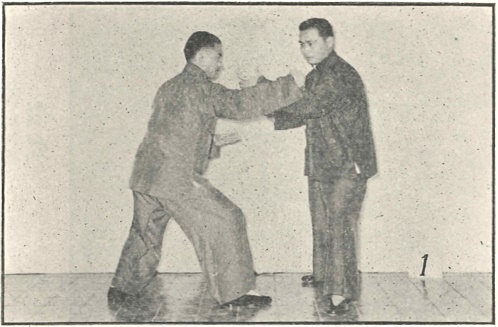
(上圖)接預備式。對方從右側面左拳打我脅部。我速向右轉身。同時右手抬起將其撥開。對方繼用右手擊我胸部。我左手提起將其掤開。同時左脚橫邁一步。弓腿。兩腿坐實。
(Photo above) Continuing from the PREPARATION POSTURE, an opponent from my right side uses his left fist to strike to my ribs, so I quickly turn my body to the right as my right hand lifts to deflect him. But he continues by using his right hand to strike to my chest, so I lift my left hand and ward him away, my left foot at the same time taking a sideways step, the leg bending, both legs sitting firmly.
(下圖)避過對方攻勢後。我右手從下往內繞一小圈。轉到對方胸部。右脚上步弓腿。全身整勁向其掤去。
(Photo below) Once I have prevented the opponent’s attack, my right hand makes a small circle, arcing inward from below and then toward his chest as my right foot steps forward, the leg bending, and I use the power of my whole body, warding him away.

–
攬雀尾 捋式
CATCH THE SPARROW BY THE TAIL – ROLLBACK POSTURE
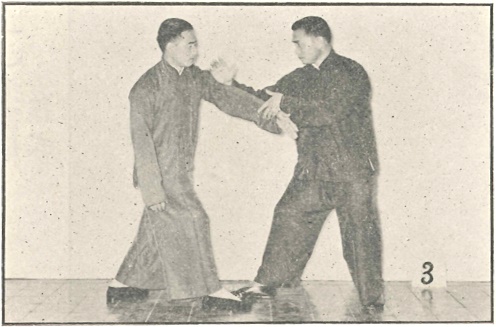
(上圖)接上掤勢。對方出左手欲乘隙擊我胸部。我左手扶其腕。右手腕粘其上臂。
(Photo above) Continuing from the ward-off posture, the opponent sends out his left hand to try to take advantage of a gap to strike to my chest, so I use my left hand to brace his wrist and my right hand to stick to his elbow.
(下圖)坐後腿。身微向左偏。雙手往後捋。將其牽動。使其後脚跟離地。重心不穩。
(Photo below) Sitting onto my rear leg, inclining my body to the left, I use both hands to do a rollback to the rear, tugging the opponent in so that his rear foot leaves the ground and his balance destabilizes.
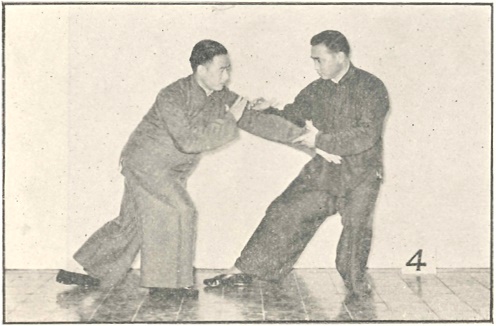
–
攬雀尾 擠式
CATCH THE SPARROW BY THE TAIL – PRESS POSTURE
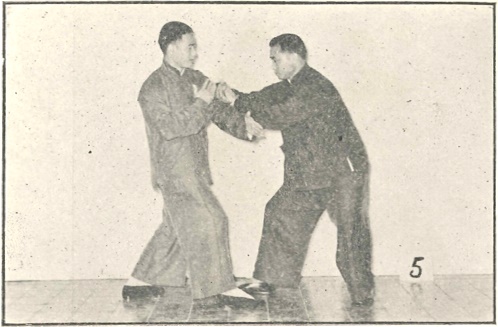
(上圖)接上捋勢。對方因不得力。欲將手抽回。我右手心翻向上。將其黏住。不使走脫。左手心翻向下。合于右腕上。
(Photo above) Continuing from the rollback posture, the opponent has no choice but to try to withdraw his arm, so I turn over my right hand so the palm is facing upward, sticking to him and not letting him get away, and turn over my left hand so the palm is facing downward, closing over my right wrist.
(下圖)乘其抽回之際。我弓前腿。蹬後腿。發勁擠出。
(Photo below) Taking advantage of the moment the opponent withdraws, I bend my front leg and straighten my rear leg as I issue energy to press him away.
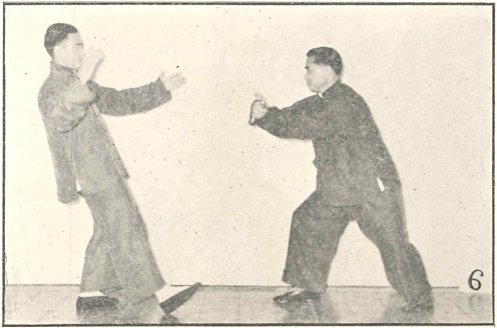
–
攬雀尾 按式
CATCH THE SPARROW BY THE TAIL – PUSH POSTURE

(上圖)接上擠勢。設對方右手來拉我右手。我右手急往上翻,手心向外。使其力背,身往後坐。乘對方因不順而變勢之時。我左手粘其肘。右手粘其腕。將彼封閉。
(Photo above) Continuing from the pressing posture, if the opponent puts out his right hand to pull on my right arm, I quickly turn over my right hand so the palm is facing outward, causing his energy to coarsen. Sitting my body back, I take advantage of the moment that his energy ceases to be smooth and makes him change his posture, my left hand sticking to his elbow, my right hand sticking to his wrist, sealing him off.
(下圖)隨蹬後腿。弓前腿。發勁將其按出。
(Photo below) Then I straighten my rear leg and bend my front leg as I issue energy to push the opponent away.

–
(二)單鞭
2. SINGLE WHIP
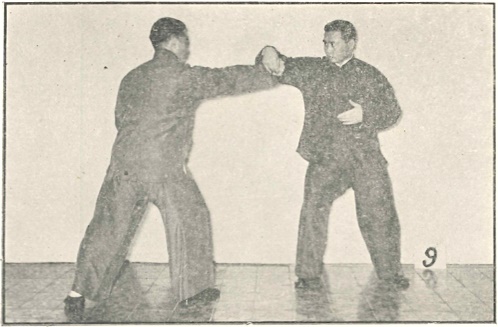
(上圖)接上攬雀尾按勢。對方從左用右手擊我脅部。我立向左轉身。右手從上繞下。將其撥開。
(Photo above) Continuing from CATCH THE SPARROW BY THE TAIL, an opponent from my left uses his right hand to strike to my ribs, so I immediately turn my body to the left, arcing my right hand upward from below to deflect it away.
(下圖)對方由左後方掄右拳從上打下。我急向左轉身。趁其拳未下之際。先發制人。左脚抬起。上步弓腿。左手繞上。手心朝外。推其胸部。
(Photo below) An opponent from the left rear swings his right fist to strike downward from above, so I quickly turn my body to the left and take advantage of the moment before his fist comes down by getting to him first, my left foot lifting and stepping forward, the leg bending, my left hand arcing upward, palm facing outward, and pushing to his chest.
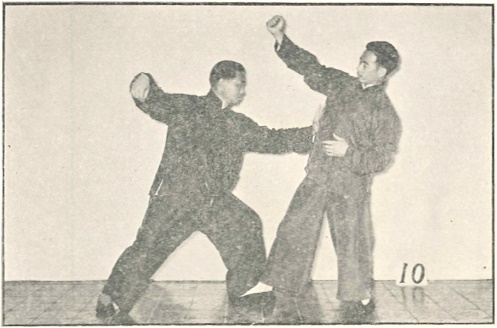
–
(三)提手
3. RAISE THE HANDS
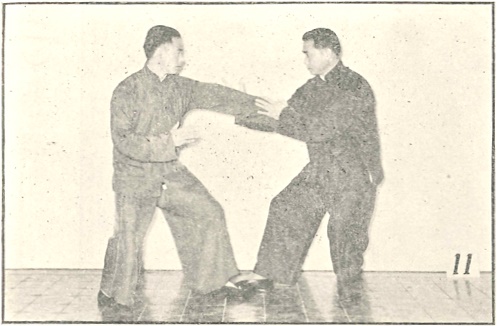
(上圖)接單鞭式。對方正面用左手直錘打來。我雙手往內合。右手在前。扶住其肘。左手在後扶其腕。同時右脚提起。置于左脚前。加强合勁。
(Photo above) Continuing from SINGLE WHIP, an opponent uses his left hand to come in with a straight punch, so I close inward with both hands, my right hand forward and bracing his elbow, my left hand behind and bracing his wrist, my right foot at the same time lifting to be placed in front of my left foot, adding to the closing energy.
(下圖)雙手保持合勁。將對方提起。使其脚跟離地。
(Photo below) With both hands maintaining this closing energy, the opponent is lifted, causing his heels to come off the ground.
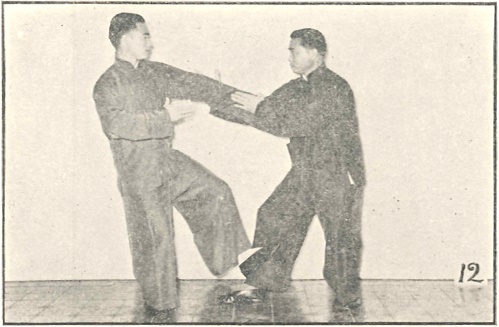
–
(四)白鶴亮翅
4. WHITE CRANE SHOWS ITS WINGS

(上圖)接提手式。對方從左方右拳直打來。我速往後坐腿涵胸避之。同時左手自下繞一小圈。再往右將其手粘住。
(Photo above) Continuing from RAISE THE HANDS, an opponent from my left punches at me with his right fist, so I quickly sit back and hollow my chest to evade it. At the same time, my left hand arcs in a small circle from below and goes to the right to stick to his hand.
(下圖)右脚上步。右手提起,用肘前節托住對方腋下往上伸。左脚往前上半步。左手往下展以助右手之勢。右手往上翻。將對方架起。
(Photo below) My right foot steps forward and my right hand lifts up, my forearm propping up under the opponent’s armpit and extending upward. My left foot goes forward a half step, my left hand extending downward to assist the energy of my right hand, and my right hand turns over upward, causing him to rise up.
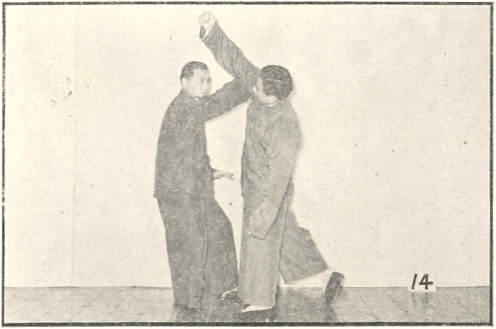
–
(五)左摟膝拗步
5. LEFT BRUSH KNEE IN A CROSSED STANCE

(上圖)接白鶴亮翅式。對方正面右錘擊我腰部。我左手往上繞一小圈。將其摟開。同時右手轉下。再繞上置耳旁。
(Photo above) Continuing from WHITE CRANE SHOWS ITS WINGS, the opponent in front of me uses his right fist to punch to my waist, so I make a small circle with my left hand, arcing upward then brushing outward, my right hand at the same time arcing downward then upward to be placed beside my ear.
(下圖)右腿坐實。左脚上步弓腿。此時兩腿坐實。右掌往前打出。
(Photo below) With my right leg sitting full, my left foot steps forward and the leg bends, and with both legs now sitting firmly, my right palm strikes out forward.
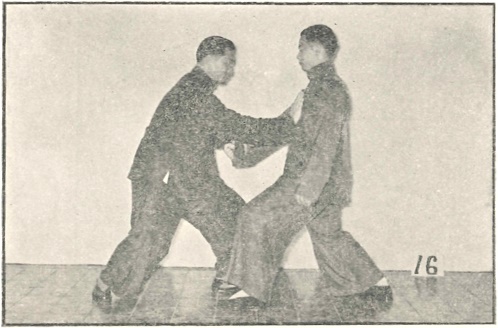
–
(六)手揮琵琶
6. PLAY THE LUTE
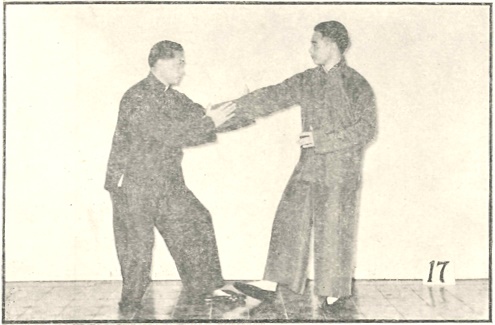
(上圖)接左摟膝拗步。對方出右手攻來。我往後坐腿。右手順勢收回。扶其掌腕之間。左手由下往上。直出托其肘。左脚收半步。
(Photo above) Continuing from LEFT BRUSH KNEE IN A CROSSED STANCE, the opponent puts out his right hand to attack, so I sit back onto my rear leg as my right hand goes along with his momentum to brace his wrist area, my left hand going upward from below and reaching straight out to prop up his elbow, my left foot withdrawing a half step.
(下圖)兩手合勁。往前上方伸。將對方發出。全身整勁。
(Photo below) My hands use closing energy to extend forward and upward, shooting the opponent out with the power of my whole body.
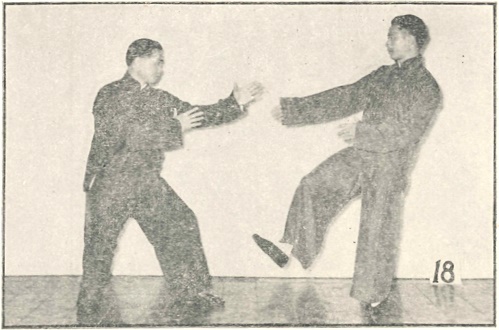
–
(七)進步搬攬錘
7. ADVANCE, PARRY, CATCH, PUNCH

(上圖)接左摟膝拗步式。對方右錘向我胸部猛力打來。我兩手速往左繞一小圈。右手握拳翻上沉下。將對方手腕粘住。左手往前伸作虛手。同時右脚橫上半步。
(Photo above) Continuing from LEFT BRUSH KNEE IN A CROSSED STANCE, the opponent’s right fist strikes fiercely toward my chest, so I quickly make a small circle, both hands arcing to the left, my right hand grasping into a fist, turning over so the center of the hand is facing upward, and sinking down to stick to his wrist, my left hand extending forward as a feint, my right foot at the same time going forward a half step with the foot sideways.
(下圖)對方攻勢落空。必將手抽回。我乘機左手沉下。制住其肘前節。左脚上步弓腿。右拳將其打出。
(Photo below) Once the opponent’s attack has missed, he is sure to withdraw his hand, so I take advantage of the opportunity by sinking my left hand down to control his forearm as my left foot steps forward, the leg bending, and my right fist strikes out.
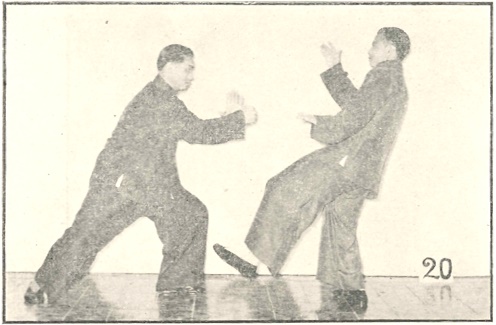
–
(八)如封似閉
8. SEALING SHUT
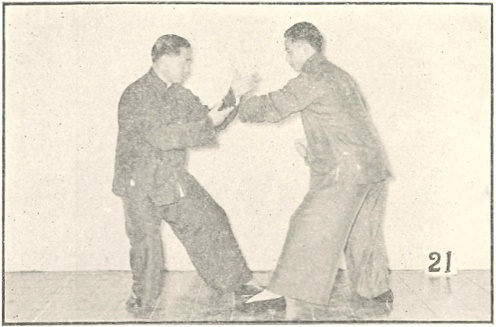
(上圖)接進步搬攬錘式。對方用左手橫撥。我右手向裏繞。左手從右腕下伸出。將對方手腕按住。右拳鬆開抽回。同時坐後腿。前腿虛。
(Photo above) Continuing from ADVANCE, PARRY, CATCH, PUNCH, the opponent uses his left hand to deflect across, so my right hand arcs inward and my left hand reaches out from below my right wrist to push on his wrist, my right fist opening up as it withdraws. At the same time, I sit onto my back leg, my front leg emptying.
(下圖)右手往前出。按住對方肘部。將對方封閉。使不能變化。弓前腿。
(Photo below) My right hand goes forward to push on the opponent’s elbow, sealing him off so that he cannot adjust, my front leg bending.
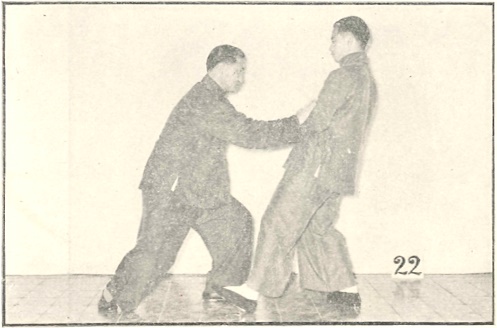
–
(九)十字手
9. CROSSED HANDS
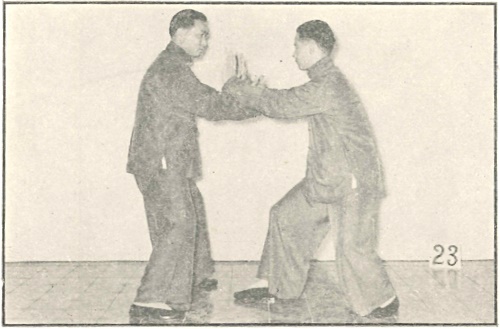
(上圖)接如封似閉式。對方從右雙手推來。我速向右轉身。兩手分開。自下繞上。作十字手架住。
(Photo above) Continuing from SEALING SHUT, an opponent comes from the right with a double-hand push, so I quickly turn to the right, my hands spreading apart and then arcing upward from below to prop up with a crossed shape.
(下圖)如對方再出力推來。我趁此時兩手往上分。將對方掤出。兩脚踏實。
(Photo below) If the opponent puts out further power to do his push, I take advantage of this moment by spreading my hands upward, sending him away by warding off while I stand firmly on both feet.
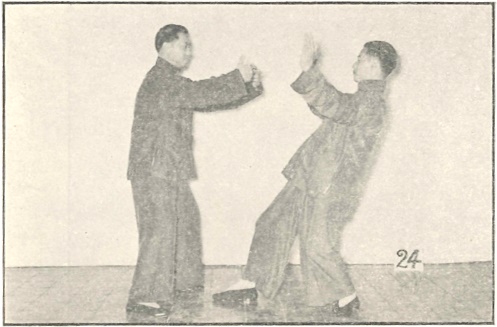
–
(十)抱虎歸山
10. CAPTURE THE TIGER AND SEND IT BACK TO ITS MOUNTAIN
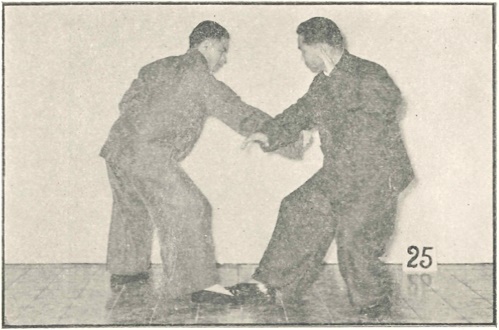
(上圖)接上十字手式。對方從右後方用右手向我腰部直打來。我速向內轉左脚。往右轉身。右手轉下將對方撥開。同時左手自下往上。繞到耳旁。左腿坐實。
(Photo above) Continuing from CROSSED HANDS, an opponent from the right rear uses his right hand to do a straight strike to my waist, so I quickly turn my left foot inward and my body to the right as my right hand arcs downward to deflect him away, my left hand at the same time arcing upward from below until beside my ear, my left leg sitting full.
(下圖)右脚上步弓腿。左手按住對方右肩臂之間。趁其不得力之時。用內勁將彼按斜。(本式以後動作。與攬雀尾捋擠按勢相同。在此從略)。
(Photo below) My right foot steps forward, the leg bending, my left hand pushing to the opponent’s shoulder area, and then taking advantage of the moment when he can do nothing, I use internal power to push him diagonally away. (The subsequent movements of this posture are the rollback, press, and push of CATCH THE SPARROW, which have already been explained.)
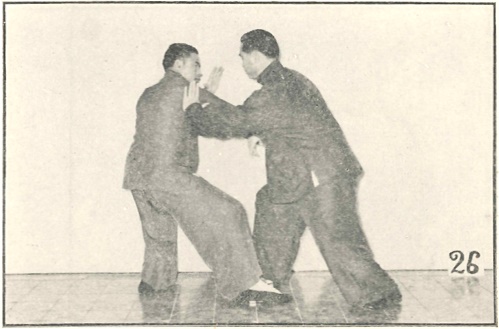
–
(十一)肘底看錘
11. GUARDING PUNCH UNDER ELBOW

(上圖)接上抱虎歸山式。對方從後擊我左胸部。我速往左轉身走兩步。面向對方。同時左手從對方錘上繞下托其肘上節。使其打空。
(Photo above) Continuing from CAPTURE THE TIGER AND SEND IT BACK TO ITS MOUNTAIN, an opponent from behind attacks the left side of my upper body, so I quickly turn my body to the left, yielding two steps, to be facing him, and as his fist arcs downward from above, my left hand props up his arm behind the elbow, causing his strike to miss.
(下圖)左脚往前邁步。右手握拳。擊對方腰部。用內勁。
(Photo below) My left foot takes a step forward as my right hand grasps into a fist and strikes to the opponent’s waist using internal power.
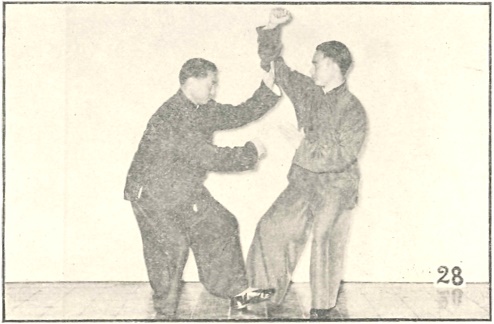
–
(十二)倒輦猴
12. RETREAT, DRIVING AWAY THE MONKEY

(上圖)接上肘底看錘式。設對方用右手猛力打來。我左脚速退一步。同時左手背粘其手腕。右拳鬆開。繞上轉至耳旁。
(Photo above) Continuing from the previous posture, if the opponent uses his right hand to fiercely attack me, I quickly retreat my left foot a step. At the same time, the back of my left hand sticks to his wrist, my right fist opening and arcing upward to be beside my ear.
(下圖)坐實左腿。右腿虛。左手用沉勁往後掛。消其猛力。右手往前伸作虛手。
(Photo below) I sit onto my left leg, emptying my right leg, as my left hand sinks down and hangs to the rear to dispel the opponent’s power, my right hand extending forward as a feint.

–
(十三)斜飛式
13. DIAGONAL FLYING POSTURE
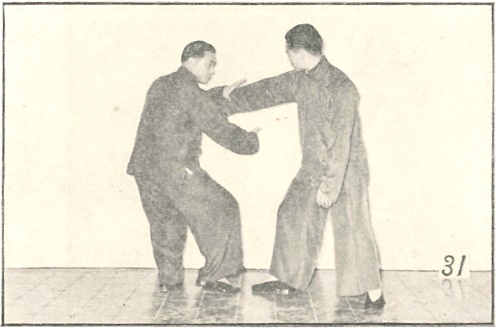
(上圖)接上倒輦猴式。設對方從右用右手擊我脅部。我速往右轉身涵虛。右手隨身形轉下。手心向上。左手粘住對方手腕。左腿實。右腿虛。
(Photo above) Continuing from RETREAT, DRIVING AWAY THE MONKEY, if an opponent from the right uses his right hand to strike to my ribs, I quickly turn my body to the right and hollow inward, my right hand going along with my body by arcing downward, the palm facing upward, as my left hand sticks to his wrist, my left leg filling, right leg emptying.
(下圖)右脚向對方襠部插進一步。用右手肘前節斜擊其膊下腋部。前腿攻。後腿蹬。作大鵬展翅勢。將其打出。用長勁。
(Photo below) My right foot advances a step below the opponent’s crotch and I use my right forearm to strike diagonally to his armpit, my front leg bending, rear leg straightening, making a posture of a “rukh spreading its wings” to strike out at him using extending energy.
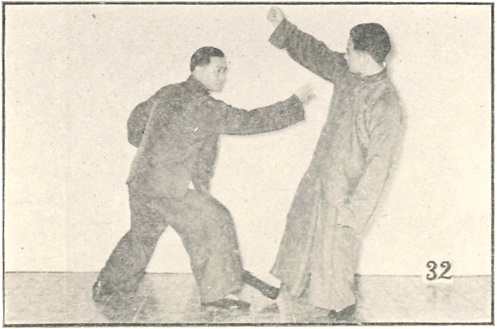
–
(十四)海底針
14. NEEDLE UNDER THE SEA
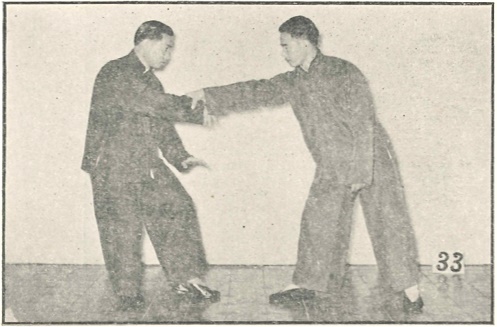
(上圖)接左摟膝拗步式。設對方將我右手腕執住。我先往後坐腿。右手往後抽回。同時前脚收回半步。將其手引長。使其力過。
(Photo above) Continuing from LEFT BRUSH KNEE IN A CROSSED STANCE, if the opponent grabs my right hand, I first sit onto my rear leg, my right hand withdrawing to the rear, my front foot at the same time withdrawing a half step, inducing him to overly extend his arm and lose his strength.
(下圖)趁對方力消時。我右手突往下沉。同時左手從內往外掛。將其撥開。
(Photo below) I take advantage of the moment the opponent’s strength dissipates by suddenly sinking my right hand down, my left hand hanging outward to deflect him aside.
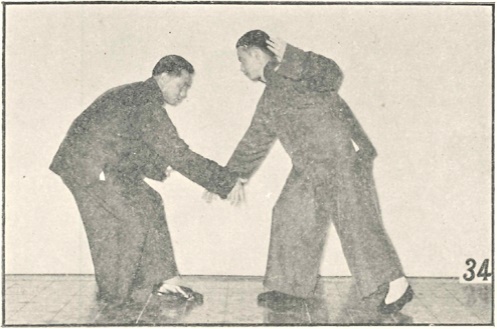
–
(十五)山通背
15. MOUNTAIN THROUGH THE BACK

(上圖)接上海底針式。將對方啄開後。對方又用右錘向我頭部打來。我右手急往上翻。將對方手腕托起。左手抽起伸前。按其腋底脅部。同時上左脚踏實。
(Photo above) Continuing from NEEDLE UNDER THE SEA, once the opponent has been deflected aside, if he now strikes to my head using his right fist, I quickly send my right hand upward, turning it over, and prop up his wrist, my left hand drawing upward and extending forward to push to his chest, my left foot at the same time stepping down fully.
(下圖)前腿弓。後腿蹬。全身整勁。按對方胸部。用長勁。
(Photo below) With my front leg bending and rear leg straightening, I use the power of my whole body to push to the opponent’s chest using extending energy.

–
(十六)撇身錘
16. TORSO-FLUNG PUNCH
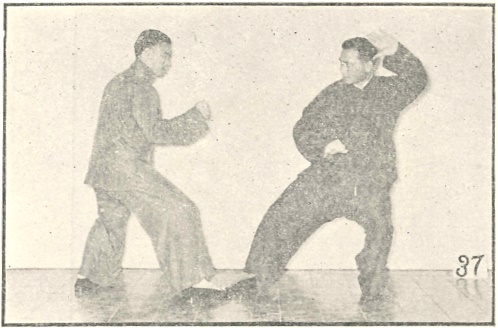
(上圖)接上山通背式。發覺背後有人預備向我襲擊。我立向右轉身。幷轉左脚。右手轉下置胸前。握拳。左手轉上。眼注視對方。
(Photo above) Continuing from MOUNTAIN THROUGH THE BACK, I sense there is an opponent behind me getting ready to make a surprise attack, so I immediately turn my body to the right, turning my left foot along with it, as my right hand arcs downward to be placed in front of my chest, grasping into a fist, my left hand arcing upward, my gaze going toward him.
(下圖)對方直錘打來。我右手翻上再撇下。壓住其肘前節。身法涵虛。使其打空。同時左手伸向其面部。作虛手以遮其眼。脚隨身轉。
(Photo below) As the opponent does a straight punch, my right hand turns over upward and then flings downward to press down his forearm, my torso hollowing so his strike will miss, my left hand at the same time reaching out toward his face as a feint to block his view, my feet turning along with my body.
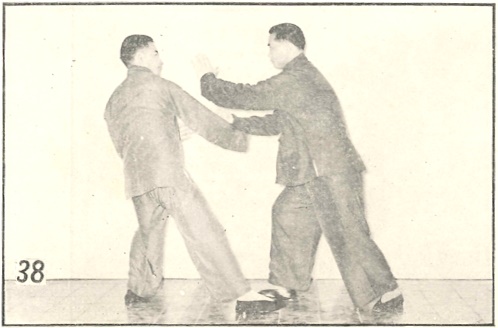
–
(十七)雲手
17. CLOUDING HANDS
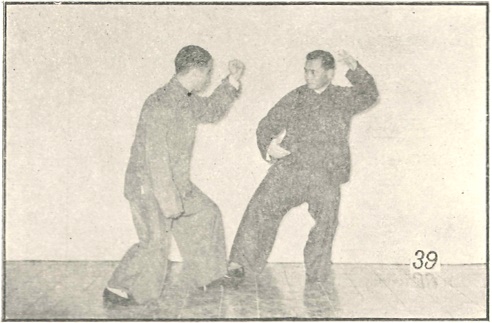
(上圖)接單鞭式。發覺右斜方有人預備向我襲擊。我右手撒手繞下。手心向內。左脚向裏轉。左腿踏實。右腿虛。眼神注視對方。
(Photo above) Continuing from SINGLE WHIP, I sense there is an opponent diagonally to my right who is getting ready to make a surprise attack, so my right hand opens up and arcs downward, the palm facing inward, as my left foot turns inward and the leg sits full, my right leg emptying, my gaze going toward him.
(下圖)對方向我上部打來。我右手往上運貼其肘前節。將彼撥開。兩腿坐實。隨運隨將對方來勁消除。(不可用頂勁)
(Photo below) As the opponent strikes toward my upper body, I move my right hand upward to stick to his forearm and deflect it aside, my legs sitting firmly as my movement dispels his incoming power. (But I must not have an energy of crashing against his attack.)
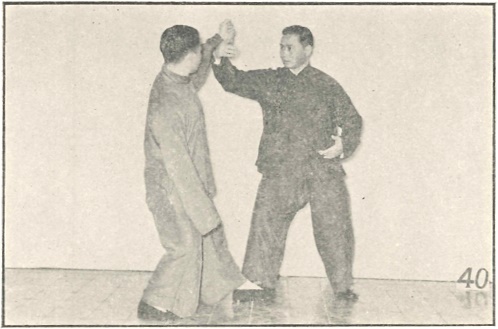
–
(十八)高探馬
18. RISING UP AND REACHING OUT TO THE HORSE
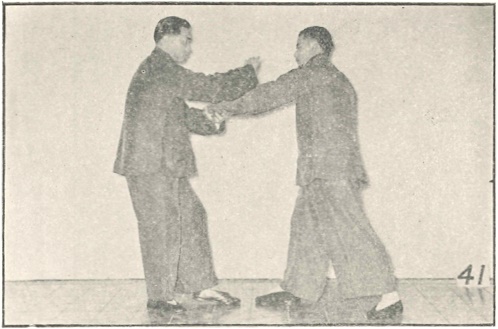
(上圖)接單鞭式。對方左手直擊我胸部。我左手隨其手收回。拿其手腕。左腿收回半步為虛。右手經耳旁伸出到其面部。
(Photo above) Continuing from SINGLE WHIP, the opponent uses his left hand to strike straight to my chest, so my left hand goes along with it, withdrawing and grabbing his wrist, as my left foot withdraws a half step, emptying, and my right hand passes beside my ear to reach out toward his face.
(下圖)如上圖旣將對方治住。此時涵胸。右手作探馬式推出。使對方立足不穩。
(Photo below) Now that I control the opponent, I hollow my chest and my right hand pushes out with the posture of “reaching out to the horse”, causing his stance to destabilize.

–
(十九)右分脚
19. KICK TO THE RIGHT

(上圖)接高探馬式。旣將對方治住。左脚向前方邁步。弓腿。右手繞外轉至對方手臂內。
(Photo above) Continuing from REACHING OUT TO THE HORSE, in control of the opponent, my left foot steps forward [to the forward left] and the leg bends, my right hand arcing around outward to the inside of his arm.
(下圖)此時左腿為實。右脚抬起。向對方腰部分去。同時兩手分開。手脚同時出力。是整勁。
(Photo below) With my left leg standing stably, my right foot lifts and kicks out to the opponent’s waist, my hands at the same time spreading apart. My hands and foot express in unison, using the power of my whole body.
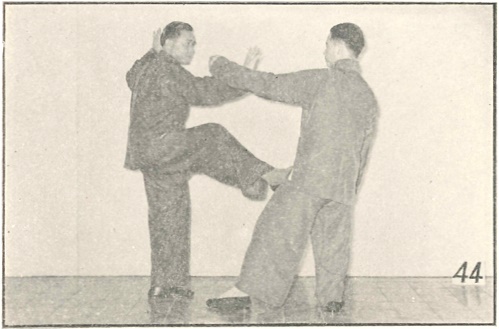
–
(二十)左轉身蹬脚
20. TURN TO THE LEFT, PRESSING KICK
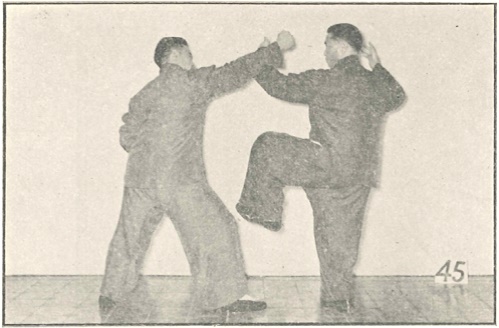
(上圖)接左分脚式。如對方從左後方用右手向我面部擊來。我向左轉身。左手分開將來手架住。右手同時分開以助平衡。右脚站穩。左脚蹬向對方腰胯。
(Photo above) Continuing from KICK TO THE LEFT, if an opponent from the left rear uses his right hand to strike to my face, I turn around to the left and spread my left hand to the left to prop up his incoming hand, my right hand at the same time spreading away to aid balance. Standing stably on my right foot, my left foot presses toward his waist or hip.
(下圖)全身用整勁。將對方蹬出。
(Photo below) Using the power of my whole body, I press out to send the opponent away.
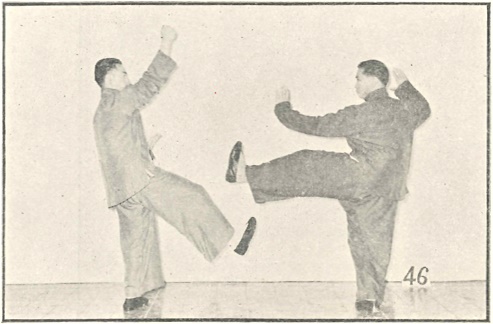
–
(廿一)進步栽錘
21. ADVANCE, PLANTING PUNCH
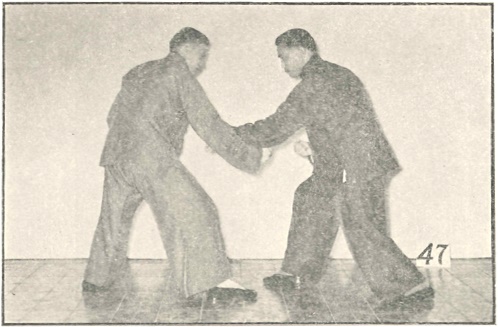
(上圖)接右摟膝拗步式。對方用右錘直打來。我用左手將他手摟開。右手握拳。手心向上。
(Photo above) Continuing from RIGHT BRUSH KNEE IN A CROSSED STANCE, the opponent uses his right fist to strike straight at me, so I use my left hand to brush his hand aside, my right hand grasping into a fist, the center of the hand facing upward.
(下圖)對方若退右脚。斜身起脚蹬我腿部。我卽上左脚。右拳向斜下方擊其小腿。(或拿住其腿亦可)
(Photo below) The opponent retreats his right foot, leans back, and lifts his [left] foot to do a pressing kick to my leg. I then step forward with my left foot and use my right fist to strike diagonally downward to his lower leg. (Or I can also grab his leg.)
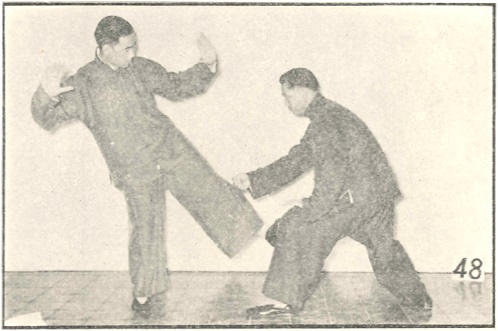
–
(廿二)斜身右蹬脚
22. INCLINING BODY, RIGHT PRESSING KICK
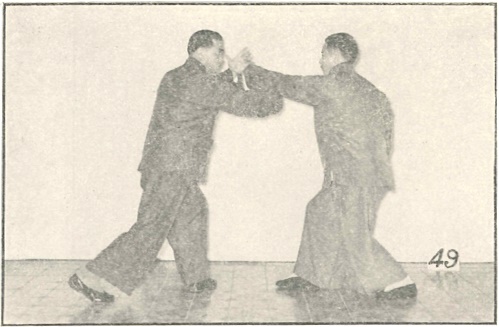
(上圖)接搬攔錘式。對方左錘擊我面部。我左手管住其手腕。身微向左斜。將擊來之力避過。右手撒開。架其上臂。
(Photo above) Continuing from PARRY, BLOCK, PUNCH, the opponent strikes to my face with his left fist, so I use my left hand to control his wrist, my body slightly inclining to the left to dodge the force of his attack, my right hand opening and propping up his upper arm.
(下圖)左脚站穩。右脚提起。蹬對方胯際。兩手分開。全身整箇勁。
(Photo below) With my left leg standing stably, my right foot lifts and does a pressing kick to the opponent’s hip using the power of my whole body, my hands spreading apart.

–
(廿三)左打虎式
23. LEFT FIGHTING TIGER POSTURE

(上圖)接斜身右蹬脚式。對方由右前面直打來。我右脚急收步置左脚旁。右手拿對方肘上節。身往左斜。左脚上步。兩腿坐實。
(Photo above) Continuing from INCLINING BODY, RIGHT PRESSING KICK, an opponent from the forward right comes in with a straight strike, so I quickly withdraw my right foot next to my left foot, my right hand grabbing his upper arm, and my body inclines to the left, my left foot stepping forward, my legs sitting firmly.
(下圖)右手將對方向左面拉斜。使其失去重心。同時左手握拳。自下繞上。向對方頭部打去。
(Photo below) My right hand pulls diagonally to the left, causing the opponent to lose his balance, my left hand at the same time grasping into a fist and arcing upward from below to strike out to his head.
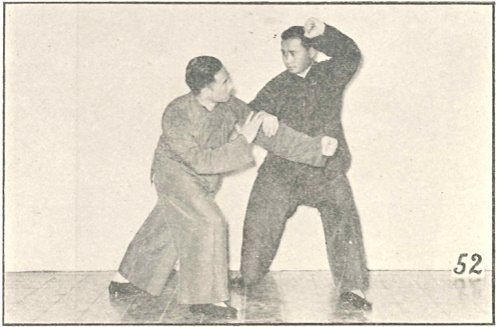
–
(廿四)囘身右蹬脚
24. TURN BACK, RIGHT PRESSING KICK

(上圖)接右打虎式。設對方由左前方用右手打來。我往後坐腿。同時右脚收半步。右手繞下轉上。托住其臂。將彼治住。
(Photo above) Continuing from RIGHT FIGHTING TIGER POSTURE, if an opponent from the forward left attacks with his right hand, I sit back onto my rear leg, my right foot at the same time withdrawing a half step, as my right hand arcs upward from below to prop up his forearm and control him.
(下圖)提起右脚。蹬對方腰胯部。將其蹬出。兩手分開作平衡勁。
(Photo below) I lift my right foot and do a pressing kick to the opponent’s waist, my hands spreading apart with balancing energy as I press out.
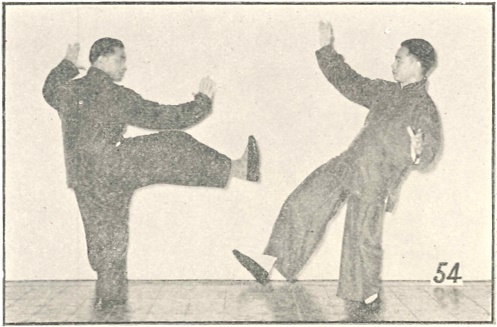
–
(廿五)雙風貫耳
25. DOUBLE WINDS THROUGH THE EARS
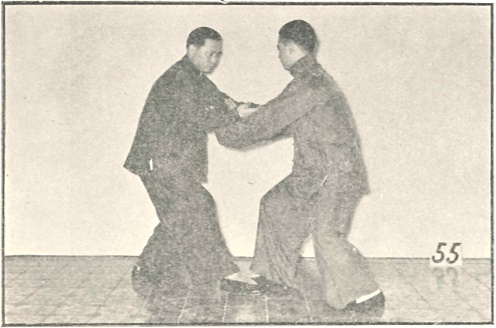
(上圖)接上回身右蹬脚式。設對方由右後方用雙手向我推來。我速向右轉身。雙手由前放下。手心向上。將對方雙手掛開。用沉勁。隨右脚上步。
(Photo above) Continuing from TURN BACK, RIGHT PRESSING KICK, if the opponent from the right rear comes in with a double-hand push, I quickly turn my body to the right, releasing my hands downward in front of me, palms facing upward, hanging the opponent’s hands aside using sinking energy, as I bring my right foot down in front.
(下圖)趁對方推空之際。我上右脚。雙手握拳。向外繞上。打對方兩耳。右腿弓。兩腿坐實。
(Photo below) Once the opponent’s push has been reduced to nothing, I step forward with my right foot as both of my hands grasp into fists which go outward and arc upward to strike his ears, my right leg bending, both legs sitting firmly.

–
(廿六)野馬分鬃
26. WILD HORSE VEERS ITS MANE
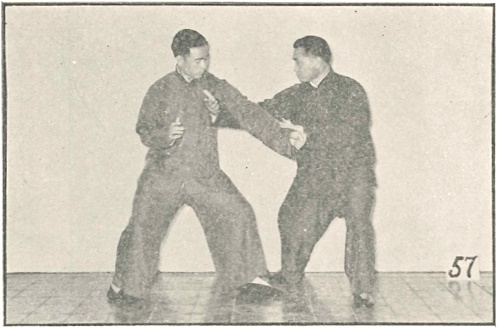
(上圖)接斜單鞭式。對方用左拳直擊來。我左手扶住來手肘前節。右手撒開。轉下再繞上。到對方胸腋間。
(Photo above) Continuing from DIAGONAL SINGLE WHIP, an opponent uses his left fist to do a straight punch, so I use my left hand to brace his forearm as my right hand opens up and arcs downward then upward to be between his chest and armpit.
(下圖)左脚往前上步。雙手作分鬃勢。右手往前上方分去。弓前腿。蹬後腿。用長勁將對方發出。
(Photo below) My left foot steps forward and my hands make a posture of a “mane swinging to the side”, my right hand spreading away forward and upward, my front leg bending, rear leg straightening, and I use extending energy to shoot the opponent away.
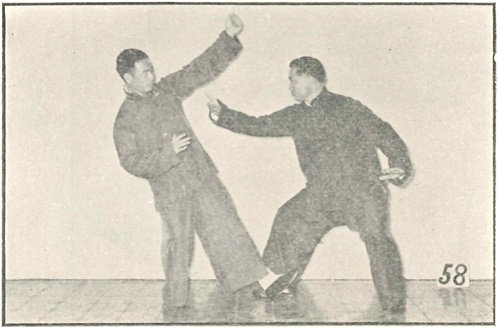
–
(廿七)左玉女穿梭
27. MAIDEN WORKS THE SHUTTLE – LEFT
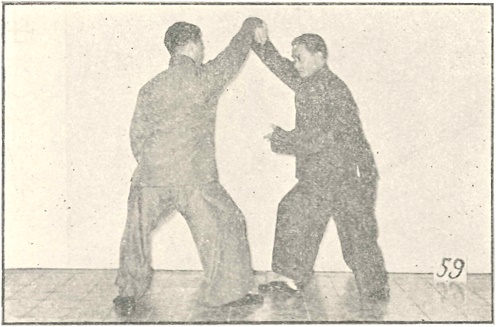
(上圖)接單鞭式。對方右手由後拿我右手。我向右轉身。左手繞下經腰部向上翻。坐左腿。右脚收回半步。涵胸。
(Photo above) Continuing from SINGLE WHIP, an opponent from behind uses his right hand to grab my right hand, so I turn around to the right, my left hand arcing downward and past my waist, turning over to face upward, as I sit onto my left leg, my right foot withdrawing a half step, my chest hollowing.
(下圖)右脚踏實。上左脚。同時左手將對方之手架開。右手向其胸部穿去。弓腿。
(Photo below) My right foot coming down fully, my left foot steps forward as my left hand props away the opponent’s hand and my right hand threads out to his chest, my [left] leg bending.

–
(廿八)單鞭下式
28. SINGLE WHIP, LOW POSTURE

(上圖)接單鞭式。對方掄右錘由上巨力打下。來勢猛烈。難以封擋。應採避勢。我急向後坐腿避過
(Photo above) Continuing from SINGLE WHIP, the opponent swings his right fist to strike down heavily from above. His power is fierce and difficult to defend against, so I choose to evade it, quickly sitting back to get out of the way.
(下圖)對方連續再掄左錘擊來。我再向後斜身坐腿避過。
(Photo below) The opponent continues by now swinging his left fist, so I sit still further back, leaning away to evade it also.

–
(廿九)金雞獨立
29. GOLDEN ROOSTER STANDS ON ONE LEG
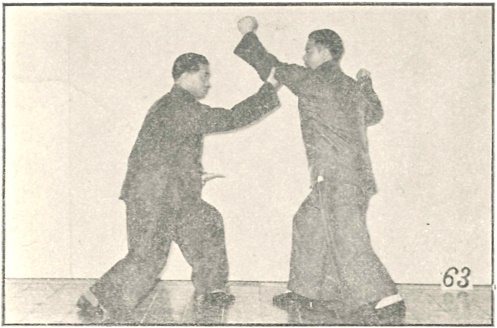
(上圖)接單鞭下式。對方連打兩錘落空。必將手抽回。趁其收回之際。我急弓前腿。身往上起。右手將對方左肘托起。
(Photo above) Continuing from SINGLE WHIP, LOW POSTURE, after the opponent’s two successive punches have missed, he is sure to pull back his hand, so I take advantage of the moment he withdraws by quickly bending my front leg, raising up my body, and propping up his left elbow with my right hand.
(下圖)左脚踏實。趁自己已將對方托起。再起右脚向對方腿部蹬去。(或踢去)
(Photo below) With my left leg standing firmly, I go along with my own action of propping up by also lifting up my right leg to do a pressing kick (or snapping kick) to the opponent’s thigh area.
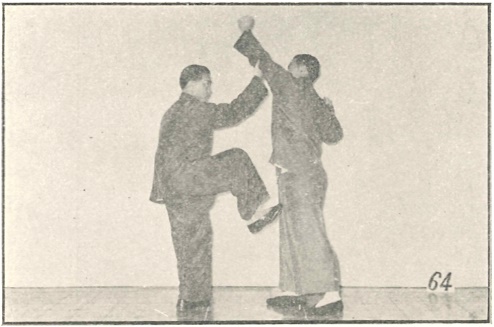
–
(三十)白蛇吐信
30. WHITE SNAKE FLICKS ITS TONGUE

(上圖)接上山通背式。發覺背後有人預備向我襲擊。我立向右轉身。同時左脚內轉。右手轉下置胸前。左手轉上。眼注視對方。
(Photo above) Continuing from MOUNTAIN THROUGH THE BACK, I sense there is an opponent behind me getting ready to make a surprise attack, so I immediately turn my body to the right, my left foot at the same time turning inward, as my right hand arcs downward to be placed in front of my chest, my left hand arcing upward, my gaze going toward him.
(下圖)對方右手打來。我右手轉上翻下。掛對方手腕。趁對方抽回時。急翻手吐向對方上部。兩腿坐實。
(Photo below) As the opponent’s right hand comes in to strike, my right hand arcs upward then downward to seal off his wrist, and then at the moment he tries to pull back, my hand quickly turns over and shoots toward his upper body, my legs standing firmly.
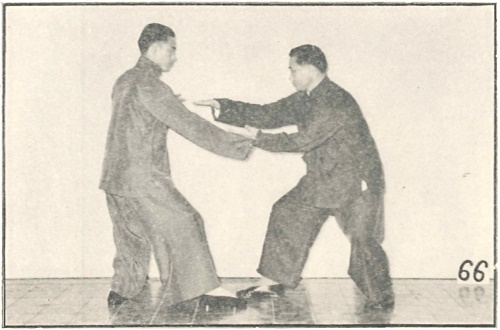
–
(卅一)高探馬代穿掌
31. REACHING OUT TO THE HORSE, SWITCHING TO THREADING PALM
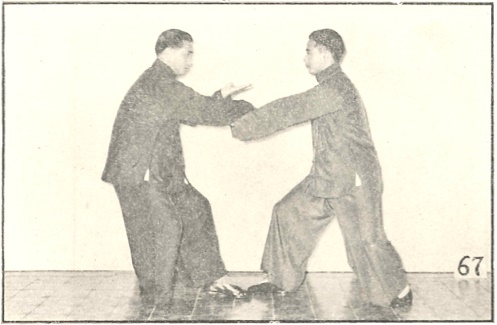
(上圖)接十八式高探馬式。向對方推出以後。對方再雙手推來。我右手橫按其肘前節。
(Photo above) Continuing from REACHING OUT TO THE HORSE, once I have pushed out toward the opponent, he then tries a double-hand push, so I use my right arm to push down crosswise on his forearms.
(下圖)左脚上步弓腿。左掌向前穿出。擊其上部。上左脚弓腿。
(Photo below) My left foot steps forward, the leg bending, as my left palm threads out forward to strike the opponent above.
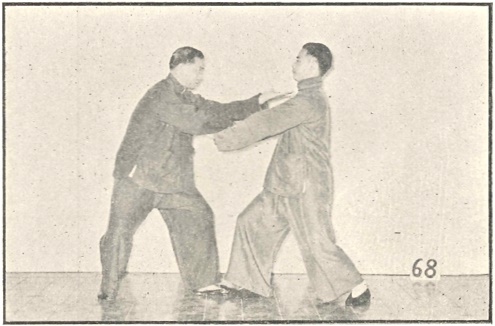
–
(卅二)轉身十字腿
32. TURN AROUND, CROSS-SHAPED KICK

(上圖)接高探馬代穿掌式。設有人在後欲向我襲擊。我向右轉身。左腿坐實。右脚收起。左手心轉向外。注視對方。
(Photo above) Continuing from SWITCHING TO THREADING PALM, if there is an opponent behind me who wants to make a surprise attack, I turn my body to the right, sitting fully onto my left leg, and my right leg withdraws and lifts, my left hand turning so the palm is facing outward, my gaze going toward him.
(下圖)對方用左手向我頭部打來。我伸左手架住。左手同張開以助平衡。起右脚向對方中部蹬去。將其蹬出。
(Photo below) The opponent uses his left hand to strike to my head, so I extend my left [right] hand to prop it up, my left hand at the same time spreading away to aid balance as I lift my right foot and press out to his midsection, sending him away.
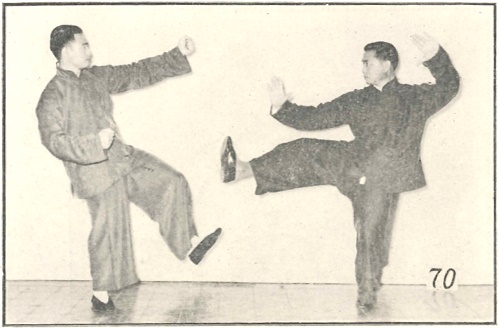
–
(卅三)進步指襠錘
33. ADVANCE, PUNCH TO THE CROTCH
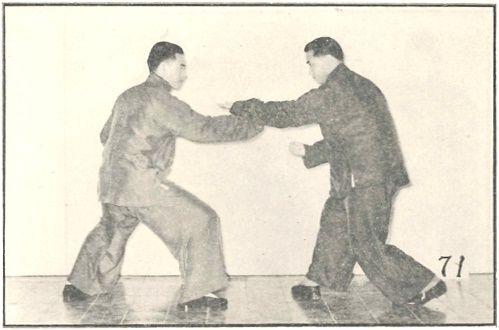
(上圖)接轉身十字腿式。將對方蹬出後。我乘勢進攻。右脚橫放下。設對方用右手向我還擊。我左手將其摟開。右手握拳。手心向上。收回置腰旁。
(Photo above) Continuing from TURN AROUND, CROSS-SHAPED KICK, after doing a pressing kick to the opponent, I take advantage of the opportunity to advance and attack, my right foot coming down sideways. If he uses his right hand to counter, I use my left hand to brush it aside as my right hand grasps into a fist, the center of the hand facing upward, and withdraws to be placed beside my waist.
(下圖)左脚上步。右拳向其襠部打去。弓腿。將其打開。
(Photo below) My left foot steps forward, the leg bending, and my right fist strikes out to his crotch, knocking the opponent away.

–
(卅四)上步七星錘
34. STEP FORWARD, BIG DIPPER PUNCH
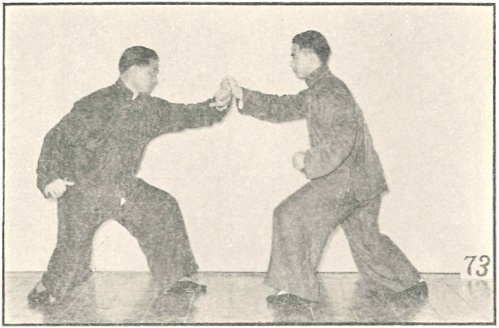
(上圖)接單鞭下勢。設對方右拳打來。我趁其尚未打到時。雙手握拳。抬左手將對方橫架。身隨手起。
(Photo above) Continuing from SINGLE WHIP, LOW POSTURE, if the opponent attacks me with his right fist, I take advantage of the moment before his strike connects by grasping both of my hands into fists and lifting my left hand toward him as a horizontal rack, my body rising along with the hand.
(下圖)右脚上步。右拳衝上擊對方上部。身手合一。是整勁。左足實。右足虛。
(Photo below) My right foot steps forward and my right fist thrusts upward to strike the opponent’s upper body, my body and hand moving in unison, and with an orderly energy. My left foot is full, right foot empty.

–
(卅五)退步跨虎
35. RETREAT, SITTING TIGER POSTURE
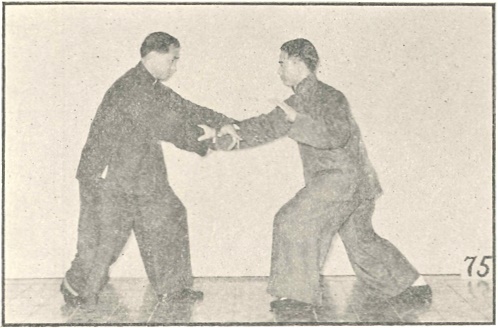
(上圖)接上步七星錘式。設對方握我右手腕。我速退右脚坐腿。將對方之手引長。使其力消失。我右拳隨卽撒開。往左撥去。
(Photo above) Continuing from STEP FORWARD, BIG DIPPER PUNCH, if the opponent grasps my right wrist, I quickly retreat my right foot and sit onto it, luring his arm into overly extending, diminishing his strength, and my right fist then opens and deflects aside to the left.
(下圖)右脚坐實。左脚往後收半步。兩手張開。身稍往右斜。作跨虎式。寓攻于守。
(Photo below) Sitting fully onto my right leg, my left foot withdraws a half step, my hands spreading apart, my body slightly inclining to the right, making a “sitting tiger” posture, an air of attack contained within a posture of defense.
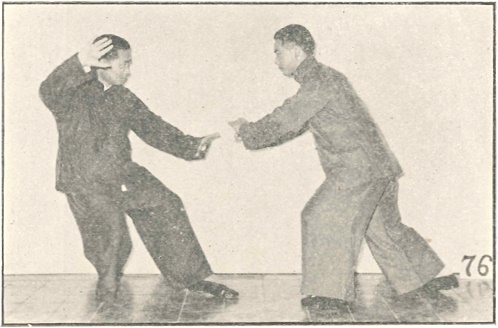
–
(卅六)轉身雙擺蓮
36. TURN AROUND, DOUBLE-SLAP SWINGING LOTUS KICK

(上圖)接退步跨虎式。設對方右拳向我頭部打來。我左手往右。右手往左。收置身前保護胸部。如對方右脚橫掃來。我速右轉身退步避開。此時仍面向對方。右脚抬起。左脚坐實。
(Photo above) Continuing from RETREAT, SITTING TIGER POSTURE, if the opponent strikes to my head with his right fist, my left hand goes to the right and my right hand goes to the left, withdrawing to be placed in front of me guarding my chest. If he sweeps across with his right foot, I quickly turn around to the right as I retreat to avoid it, and once I am again facing him, my right leg lifts, my left leg sitting firmly.
(下圖)趁對方掃空之時。我左脚往右向其胯部橫踢。如對方再用右手打來。我兩手同時往左捋。手足幷用。
(Photo below) Taking advantage of the moment in which the opponent’s sweep has missed, my left [right] foot kicks across to the right toward his hip. If he now uses his right [left] hand to attack, I also do a rollback to the left with both hands, my hands and foot working in unison.

–
(卅七)彎弓射虎
37. BEND THE BOW, SHOOT THE TIGER

(上圖)接轉身雙擺蓮式。對方右手自前打來。我雙手往右將來手拿住。右脚往右前方上步。弓腿。我雙手順勢稍向上提起。以消其力。
(Photo above) Continuing from TURN AROUND, DOUBLE-SLAP SWINGING LOTUS KICK, the opponent uses his right hand to strike forward, so I send both hands to the right to grab his arm, my right foot stepping to the forward right, the leg bending, my hands going along with its momentum by slightly lifting up, dispelling his force.
(下圖)對方被拿住。必更出力抵抗。我作彎弓勢。隨一撒手。將他連手帶人整個射出。用全身整勁。兩腿坐實。
(Photo below) Once the opponent has been grabbed, he is sure to give increased resistance, so I make the posture of “bending a bow” and then with a release of my hands, using the power of my whole body, the connection through his arm causes his body to be sent away like an arrow, while I sit firmly on both legs.
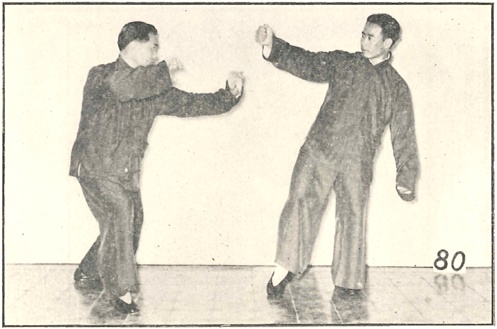
–
四正四隅使用法
METHODS OF APPLYING THE FOUR PRIMARY TECHNIQUES & FOUR SECONDARY TECHNIQUES
–
掤
WARDING OFF

(上圖)對方掄右拳打下。我右手對準其肘前節橫提起。將其避過。
(Photo above) The opponent swings his fist to strike downward, so I lift my right arm crosswise toward his forearm in order to prevent it.
(下圖)我右手繼續不停向斜上方掤去。用全身整勁。左手提起作助力。兩腿為實。此卽仰之彌高。
(Photo below) My right arm does not pause, continuing diagonally upward and warding the opponent away, using the power of my whole body, my left hand lifting to assist, my legs sitting firmly. This is an example of “when looking up, it is still higher”.

–
捋
ROLLING BACK

(上圖)對方左拳朝上衝來。我急往左偏身涵虛。雙手提起。左手握其腕。右手肘前節托其上臂。往上捋。
(Photo above) The opponent’s left fist comes in with an upward thrust, so I quickly incline my body to the left and hollow inward, both hands lifting, my left hand grasping his wrist, my right forearm propping up his upper arm, and I do an upward rollback.
(下圖)對方旣不得力。出右手來拿我右腕。我右手急反握其右腕。隨卽退右脚坐腿。我左手肘前節粘其右上臂。往斜下方捋。
(Photo below) The opponent has no choice but to send out his right hand to grab my right wrist, so I quickly turn over my right hand to grasp his right wrist, then retreat my right foot and sit down, my left forearm sticking to his right upper arm, and I do a rollback diagonally downward.
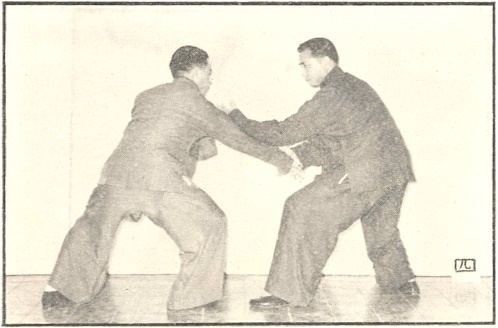
–
擠
PRESSING

(上圖)我出右拳。對方若用右手來拉。我急順勢彎肘橫向其胸部。將對方擠住。使其不能走脫。左手抬起。預備雙手擠去。
(Photo above) As I put out my right fist, if the opponent uses his right hand to pull on it, I quickly go along with the momentum by bending my elbow across in front of my chest and pressing toward him so he is unable to get away, my left hand lifting in preparation to press out with both hands.
(下圖)右脚上步弓腿。兩腿坐實。左手掌擠住右手腕。雙手向前擠。將對方發出。
(Photo below) My right foot steps forward, the leg bending, both legs sitting firmly, as my left palm touches my right wrist and both hands press forward to shoot the opponent away.

–
按
PUSHING

(上圖)我右拳打出。設對方用右手迎擋。我右手微提。往後繞一小圈。對方見形勢不利。必欲將手抽回。
(Photo above) As I strike out with my right fist, if the opponent uses his right hand to block it, my right hand slightly lifts and arcs in a small circle to the rear. When he notices he is no longer in an advantageous position, he will want to withdraw his hands.
(下圖)我拳撒開。趁機按其腕。同時出左手按其肘部。上右脚弓腿。雙手按出。將其按斜。
(Photo below) My fist opens and takes advantage of the opportunity to push on the opponent’s wrist, my left hand at the same time pushing on his elbow. I step forward with my right foot, the leg bending, as I push out with both hands, my push leaning him away.
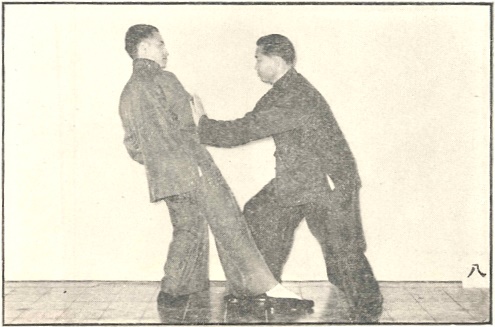
–
採(其一)
PLUCKING (version 1)
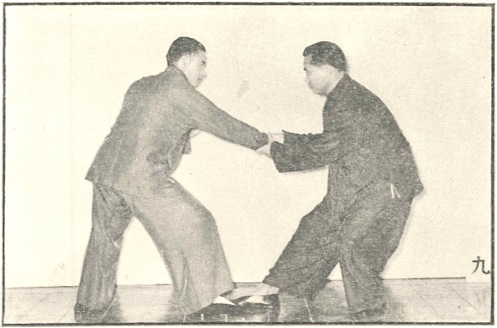
(上圖)對方右手打來。我右手將其腕拿住。(手心向下。)涵虛坐腿。左手隨卽補助右手。(兩手心相對)
(Photo above) The opponent’s right hand comes in to strike me, so I use my right hand to grab his wrist (the center of the hand facing downward). I hollow inward and sit down as my left hand then aids my right hand (the centers of both hands facing toward each other).
(下圖)我身稍右偏。雙手同時往右後方向下採。用寸勁。隨卽撒手。將其採跌。步法後腿實。前腿虛。
(Photo below) My body slightly inclining to the right, my hands pluck downward in unison to the right rear using inching energy, my hands releasing to send the opponent stumbling away due to the pluck. My stance is rear foot full, front foot empty.
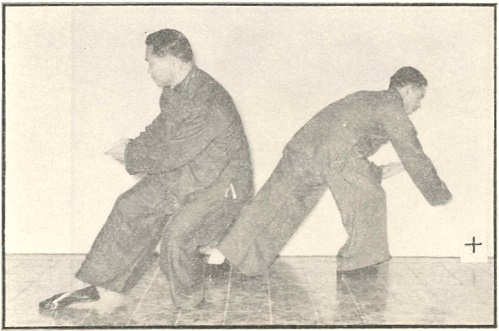
–
採(其二)
PLUCKING (version 2)

(上圖)我右手向前伸出。對方用右手迎擋。我右手急將其腕粘住。
(Photo above) I reach out forward with my right hand and the opponent blocks it with his right hand, so I use my right hand to suddenly stick to his wrist.
(下圖)我身稍右偏。右脚退步。雙手往右後方向下採。用寸勁。隨卽撒手。將其採斜。使其馬步搖動。我可趁此時機。雙手化作按式或其他方式均可。
(Photo below) My body inclines slightly to the right and my right foots retreats as both of my hands pluck downward to the right rear using inching energy, then I release my hands to make the opponent lean due to the pluck, causing his stance to wobble. I can now take advantage of the opportunity to switch both hands to performing pushing or some other technique.

–
挒(其一)
RENDING (version 1)
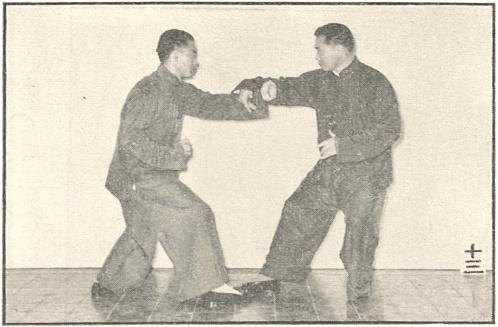
(上圖)對方左拳打來。我速虛神。右手抬起。繞到其手臂裏使肘旁。手指向下。
(Photo above) The opponent’s left fist comes in to strike me, so I quickly empty my mind, my right hand lifting and arcing around to the inside of his forearm to bring his elbow to the side, my fingers pointing downward.
(下圖)身形微提。右手將對方挒斜。用寸勁。隨此式後。我可用按式或擠式進攻。
(Photo below) My body slightly lifting, my right hand rends the opponent away diagonally using inching energy, after which I can use pushing or pressing to attack him.

–
挒(其二)
RENDING (version 2)

(上圖)對方右拳向我頭部攻來。我速虛神坐低。左手抬起。從裏繞到其肘前節。
(Photo above) The opponent’s right fist attacks toward my head, so I quickly empty my mind and sit down, my left hand lifting, arcing to his forearm from the inside.
(下圖)左手往左後方挒。用提勁。隨此式後。我宜用搬攬錘或指𦡁錘進攻。
(Photo below) My left hand rends to the left rear using lifting energy, after which I should use PARRY, GRASP, PUNCH or PUNCH TO THE CROTCH to attack.

–
肘(其一)
ELBOWING (version 1)
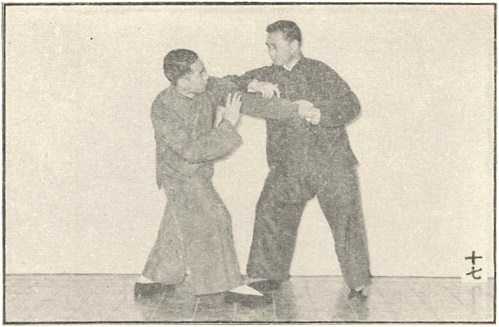
(上圖)對方左手向我上部攻來。我往左閃身。左手從內繞外。扶住其手腕。右肘抬起。橫置其肩下。
(Photo above) The opponent attacks my upper body with his left hand, so I dodge my body to the left as my left hand arcs outward from inside to brace his wrist, my right elbow lifting to be placed crosswise below his shoulder.
(下圖)上步,兩腿坐實。用整勁。將對方向橫發出。
(Photo below) Stepping forward, I sit firmly on both legs and use all my power to shoot out the opponent sideways.
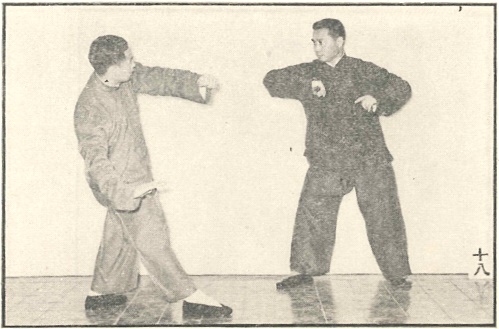
–
肘(其二)
ELBOWING (version 2)
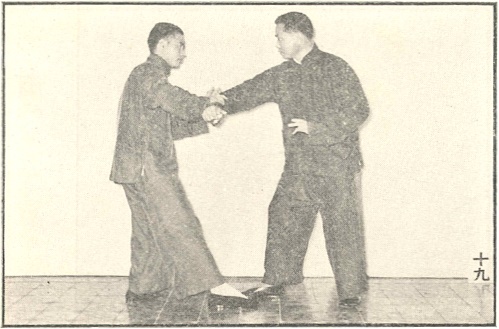
(上圖)我出右手。對方用右手來拉。我趁勢右脚上步。
(Photo above) I put out my right arm and the opponent uses his right hand to pull on it, so I take advantage of the momentum by stepping forward with my right foot.
(下圖)此時用手肘向其胸部進攻。左手扶住右手。以作助力。兩腿坐實。弓前腿。
(Photo below) I now use my elbow to attack the opponent’s chest, my left hand bracing at my right arm to assist, my legs sitting firmly, the front leg bending.
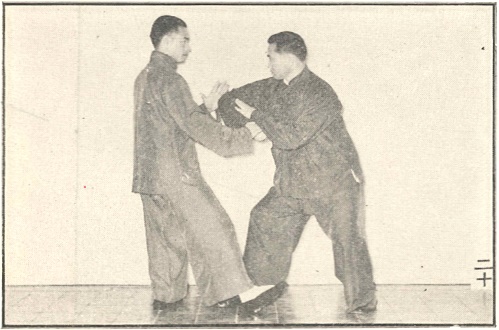
–
靠(其一)
BUMPING (version 1)
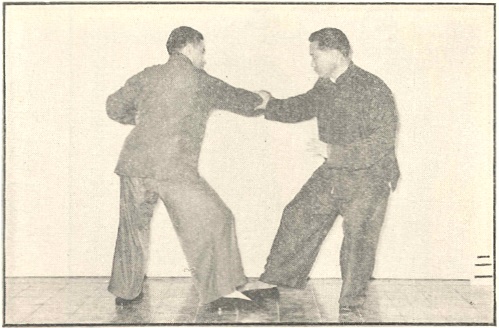
(上圖)對方出右手。我右手伸前將其腕握住。往右拉斜。握時不可太緊。手臂不可太直。
(Photo above) The opponent puts out his right arm, so I reach my right hand forward to grab his wrist and pull diagonally to the right. When grabbing, you must not grab too tight and your arm must not become too straight.
(下圖)上步弓腿。我右肩向對方右脅靠出。右手撒開。左手提起作萬一之預備。靠時身形不可太往前仆。後腿不可完全蹬直。
(Photo below) Stepping forward [with my right foot], the leg bending, I bump toward the opponent’s right ribs with my right shoulder, letting go with my right hand, my left hand lifting in slight readiness. When bumping, you must not lean too far forward and your rear leg must not fully straighten.
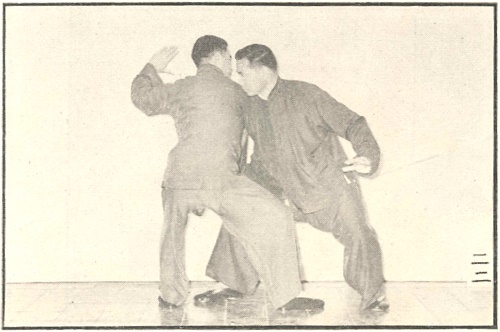
–
靠(其二)
BUMPING (version 2)
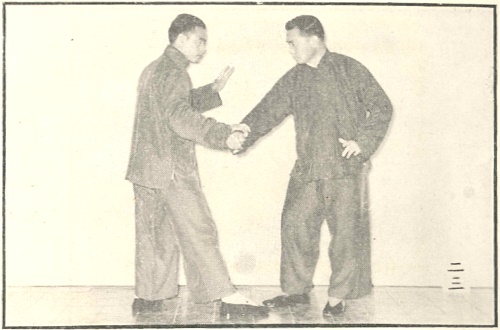
(上圖)我先出右手。如對方用右手來採。
(Photo above) I put out my right arm and the opponent plucks it with his right hand.
(下圖)我順勢右脚上大步。弓腿。右肩向對方胸部靠去。左手貼上臂作助力。靠時身不可太偏。
(Photo below) I go along with the momentum by taking a large step forward with my right foot, the leg bending as I use my right shoulder to bump to the opponent’s chest, my left hand assisting close above the forearm. When bumping, your body must not overly lean.
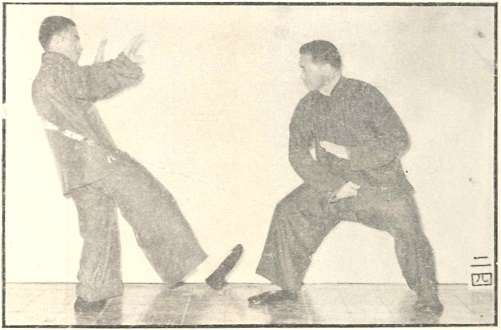
–
–
–
